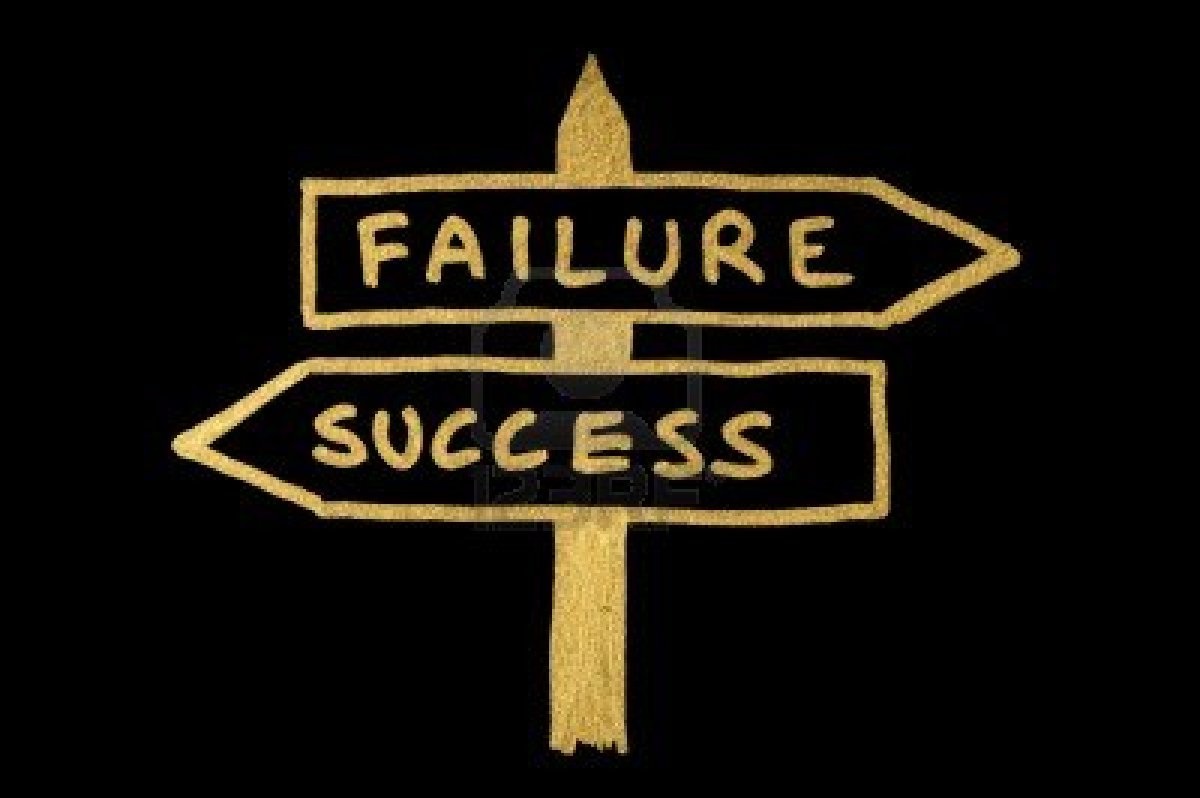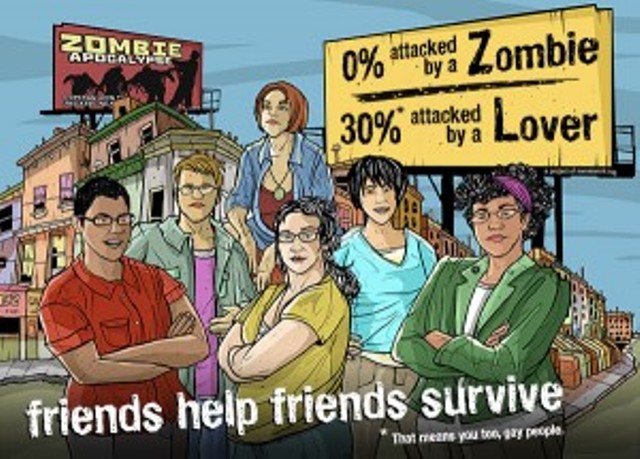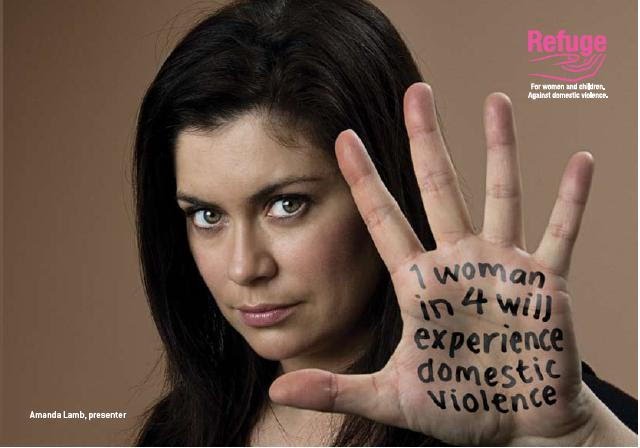Ferguson and Community Trauma: Defining Peace For Ourselves
Feature image via The Guardian
This piece was originally published on 1/12/2005.
George Floyd was murdered on May 25, 2020, and we stand in unequivocal support of the protests and uprisings that have swept the US since that day, and against the unconscionable violence of the police and US state. We can’t continue with business as usual. We will be celebrating Pride as an uprising. This month, Autostraddle is focusing on content related to this struggle, the fight against white supremacy and the fight for Black lives and Black futures. Instead, we’re publishing and re-highlighting work by and for Black queer and trans folks speaking to their experiences living under white supremacy and the carceral state, and work calling white people to material action.
Author’s Note (06/24/20): Five years after having written this article, I find myself living in the so-called US capital. Washington D.C., also happens to be one of the most over-policed cities in the United States with at least 28 different police forces operating in the District. Twenty-eight different forces to criminalize a predominantly Black territory. Twenty-eight different forces of occupation to control a city that must play host to the political machinations of every genocidal Head of State, but strategically withholds tools of political enfranchisement from its residents. In this current moment of Uprising, the Police State has fought tooth and nail to target and staunch any liberatory acts that have translated to “looting,” destruction of property, or so-called violence by violently persecuting and prosecuting (primarily) Black people. These attempts to end the so-called violence is so obviously a tactic to silence the one language that the State listens to because it was successful: people were listening. I share this life update that no one asked for because I realize that when I wrote this article five years ago, I overlooked two things that I would like to name now.
I advocated against speaking around violence, but inadvertently spoke around something else important. It is important to name that while police brutality and State violence target people of color, we have to be intentional about when we say “people of color” and when we say “Black”. In the years since writing this and other pieces, a phrase that addresses this phenomenon has become more popular: “Don’t say people of color when you mean Black.” I am leaving the original use of “people of color” to give readers an opportunity for some critical thinking. As you read this piece, I hope that when you encounter the word “people of color” you will pause and ask yourself, “how might Black people experience this differently than other people of color?” For example, people of color are victim blamed for the violence we experience and for the so-called violence we use to liberate ourselves; but, how might the victim blaming take a different form for Black people? What allowances are other communities of color given that are withheld from Black communities?
The last thing that I originally overlooked but is glaringly obvious to me now is that I did not speak to the violence of the Carceral State. As my political lens has grown and become more explicitly geared towards decarceration, I think a shortcoming of this article was to overlook the way the prison industrial complex often “finalizes” the work of this white supremacist genocidal project. It is a mechanism of social control to dissuade us from using violence for liberation, it disappears people from our communities, and it reframes our own narratives of freedom by encouraging us to adopt and justify punitive practices within our own organizing efforts. In this particular moment of Uprising, the State is using terrorism and conspiracy charges to cage and destroy freedom fighters. It’s not enough to fight for our right on the outside to heal from and use violence when necessary; we must also fight for our communities who are disappeared behind prison walls.
“There’s blood on many hands tonight — those that incited violence on the street under the guise of protests, that tried to tear down what New York City police officers did every day,” the head of the Patrolmen’s Benevolent Association, Patrick Lynch, said after two NYPD police officers died at the hands of gunman Ismaaiyl Brinsley. For police forces across the United States, which exist as emblems of institutionalized violence and white supremacy, the blood of slain officers comes as a surprise. Police officers aren’t supposed to suffer; they are instead promised glory for fulfilling America’s agenda to exterminate and destroy. There truly is blood on many hands tonight and many nights past and future; but, for many of us people of color, we are born in bloodshed and will continue to shed blood for a country that depends on our death for its life.
Violence is a fact of life for far too many marginalized peoples, especially for queer and trans people of color. We speak around violence, like it’s a sob caught in the back of our throats. I want to examine the various manifestations and influences of violence specifically in communities of color. Social forms of violence aggressively prey on our communities, carrying out an orchestrated, intergenerational genocide. Violence also carries with it political impulses, from the violence we face from oppressive systems to the historical uses of violence in various movements. I very much believe that for many communities of color, violence is both a weapon against and a tool to empower us. I don’t want to speak around violence anymore. This is my attempt to overcome an inherited fear of acknowledging the socio-political brutalities our communities face, and to speak about violence.
Community Trauma
Children are more likely than adults to experience and witness violence, placing the roots of our community’s violence in childhood. We like to imagine childhood as an age of innocence and honored humanity, but especially for children of marginalized populations, that innocence is denied to them from the onset of life. In 2011, National Surveys of Children’s Exposure to Violence (NatSCEV) interviewed a group of young people to measure the different types of violence that children experience. The survey determined that in 2011, nearly one-half (41%) of children were physically assaulted within the previous year, and more than half (55%) had been assaulted during their lifetime. The survey also found that children often experienced violence multiple times with 48% of children reporting more than one form of victimization in the past year.
The above statistics do not take into account how race, gender, and sexuality influence the violence that children of color experience, and that police brutality, drug related crimes, and systemic violence perpetuated by the healthcare system, education system, and economy disproportionately influence communities of color. (The NatSCEV study does include a portion about gender in a different excerpt.)
The degradation of the person of color begins psychologically, as children who witness or experience violence often demonstrate symptoms of repetitive traumatic dreams, cognitive confusion, pervasive pessimism, and a “sense of a foreshortened future” (Groves, Betsy McAlister. Children Who See Too Much). The degradation of the person of color begins cognitively, as neurological changes that can increase impulsive and violent behavior lead to “lower cognitive functioning, poor school performance, lack of conflict-resolution skills, limited problem-solving skills, pro-violence attitudes, belief in rigid gender stereotypes and male dominance” (Muscari, M. “How Does Exposure to Violence Affect Children?”).
The degradation of the person of color begins spiritually, with the victim blaming that mainstream society flings at people with a history of trauma. The degradation of the person of color begins intentionally, when a country that has displaced, oppressed, slaughtered, and brutalized so many people of color designs a system to implement the destruction of a individual’s humanity on a community level in the name of white supremacy.
We see violence not only in the crimson of blood spilled far too many times but also in the varying shades of brown on the skins of people of color. To be a person of color in the United States, and in the global narrative, is to be the shadow of violence. Our trauma manifests on a community level, to an extreme that self-perpetuates violence intergenerationally to keep us oppressed. The intergenerational cycle of violence begins as violence breeds trauma. Traumatized children become traumatized adults, and due to structural inequalities that forge barriers between people of color and adequate healthcare that may reduce the harm of said trauma, these traumatized adults are forced to carry the burden of their society-inflicted pain. Trying to overcome a capitalist system that economically disenfranchises people of color, housing inequalities that cage people of color in environmental disadvantaged areas, and a number of other societal hindrances, many of these adults will raise the next generation to the best of their abilities, but these children already inherit the trauma that precedes them. What institutions of white supremacy, like the police force, fail to understand is that if violence is our inheritance, it can also be our birthright. If we can engage in community-level healing to disrupt the power of trauma over our communities, we can turn violence on its head and use it as a tool for our liberation.
Violence as a Strategy
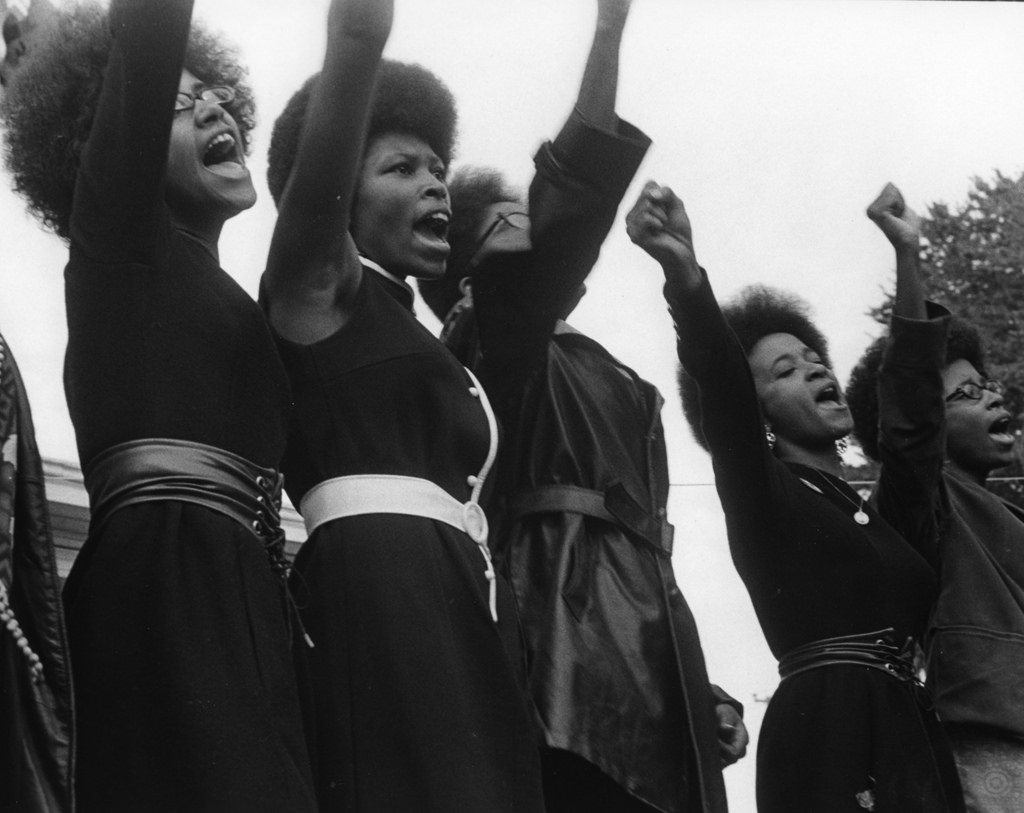
via Golden GatExpress
Women of the Black Panther Party
If I had a dime for every time mainstream media fed the public the most sanitized versions of liberation struggles, I would be able to pay off my student loans in one shot. Hetero-patriarchal white supremacist portrayals of marginalized peoples’ successful efforts for liberation as passive, coded through the language of “non-violence,” is an act of historical violence. It robs communities of their own agency and places the burden of justice on oppressed people’s ability to ask for their humanity just right instead of on the oppressor to recognize the everyone’s humanity. In late November, when a Ferguson grand jury acquitted Darren Wilson in the shooting death of teenage Michael Brown, one of the first things President Obama made sure to emphasize was that angry people of color should be peaceful. Asserting that he has “no sympathy at all for destroying your own communities,” President Obama pointed out:
“There are productive ways of responding and expressing those frustrations, and there are destructive ways of responding,” Obama said. “Burning buildings, torching cars, destroying property, putting people at risk — that’s destructive and there’s no excuse for it. Those are criminal acts. And people should be prosecuted if they engage in criminal acts.”
The rhetoric of peaceful protests that the faux progressive, white supremacist State promotes is a distortion. Peaceful protests, most eagerly invoked in reference to the Civil Rights Era of the 1960s, were a strategy, not a cure-all or a default method for liberation. In fact, even when Civil Rights leaders like Dr. Martin Luther King Jr., or Bayard Rustin championed nonviolence as a tactic, they were actively engaging with violence. The nonviolence of protesters in the 1960s only furthered their cause to the extent that the violence of white supremacists remained present.
Revolutionary organizations and individuals also used violence as a direct strategy in their work. From the Black Panther Party, to the American Indian Movement, to the Stonewall rioters, marginalized people make gains through “violent” means as well as nonviolent methods. The mainstream argument that violence will not achieve liberation is a mechanism for control that seeks to make marginalized people complicit in their own oppression. It is a plea for people of color, women, poor folks, queer people, trans people, disabled people, and anyone who happens to find themselves at the intersection of any or all of those identities to make their emancipation efforts as convenient and comfortable for the oppressor as possible.
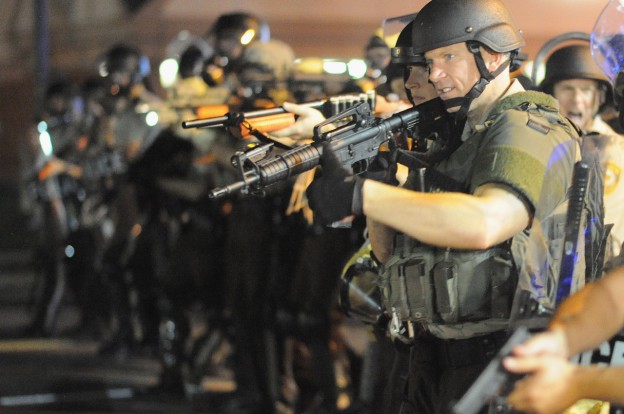
via Here And Now
Pictured above, nonviolent police officers kindly advocating against injustice
Assata Shakur wisely defended that “nobody in the world, nobody in history, has ever gotten their freedom by appealing to the moral sense of the people who were oppressing them.” A murderous State cannot tell us that we must protest “peacefully.” An appropriative State can’t instruct us not to destroy communities that we’ve never been allowed to fully own. In fact, revolutionary philosopher Frantz Fanon believed that only absolute violence could disrupt the white supremacist system of oppression because it undoes the violence created to keep the oppressed obedient and complacent.
This thought piece is not a call to set fire to everything within a 10 mile radius of your computer; however, it is an examination of violence in our queer communities of color, as well as in our white supremacist nation states. America doesn’t have a conscience, and every acquittal of racist cops who continue the genocide America has spent the last few centuries endorsing proves it. America can’t thrive off of violence and death and still define the moral high ground for liberation. So a murderous State can’t tell us queer folks of color, poor queers, disabled queers, and everyone in between that we must protest peacefully in order for us to get justice. Many of our ancestors were violently forced to build this nation, and it is our birthright to tear it down.
Ownership of Violence
Violence features so prominently in many of our communities, and yet it exists as the unacknowledged specter in queer spaces, and particularly in spaces for queer people of color. In a self-preservative gesture, I think we speak around violence in an effort to have some reprieve from it. While it is important for us to forge spaces in our communities that are explicitly nonviolent to give us a chance for collective healing, we must speak loudly about the violences we face and as a result take ownership of them. We must recognize that the majority of us are covered in someone’s blood, if not our own. When we own the violence we face, we can begin to break the shackles of trauma that keeps our communities disenfranchised and oppressed. We can fortify our communities with love and with hope. Moreover, if we own our violence, instead of fearing it because we see how violence has wrecked our families, neighborhoods, and communities, we can use violence as a tool for liberation, when it is necessary.
We are violence (though not necessarily violent) by nature of our marginalization, but we are also so powerful and so empowered. With every “riot” or protest, I see my fellow people of color, QPOC, and even allies breaking chains of oppression. Violence may have created the state of our world, but we have the right to choose and define peace for ourselves. And the peace I speak of, the peace I dream of is not the State’s model for absolute submission, but our aspiration for liberation.
An Open Letter to Everyone Afraid of Failure
feature image via shutterstock
Dear recent gradu-queer and any queer on the struggle bus,
Welcome to this shit show called adulthood! (If anyone tells you adulthood is not some kind of a shit show, I give you permission to bite them on the nose for lying.) Perhaps you’ve recently bid farewell to some university or college, with or without your sanity, self-esteem, and/or personal values. Or, perhaps, you’ve long ago hung up your cap and gown, or you left “higher” education without the pomp and circumstance. Or, maybe you never fit quite neatly into the post-high school narrative. Somewhere in any and all of these options, you’re supposed to have found a job or degree, and the world makes you feel worthless if you don’t have either or both. It’s fascinating how in the blink of an eye, people stop asking you what you want to be when you grow up and start asking “What are you doing with your life?” It’s terrifying how both of those questions bind your value to dollar signs.
Especially if you don’t have a career plan or degree trajectory mapped out, the “What are your plans?” question can sound more like a death knell than a polite inquiry into the state of your life. That loaded question is kind of a death knell insomuch as it values your contributions to a capitalist infrastructure more than it values your personhood. I am writing to you today to say your humanity — your individuality, your sense of self-worth, the life experiences that bring you to your next inhale, the way you chew with your mouth open, the way you own your truths (or don’t) — matter far more than how conveniently you fit into an economic system that was created to oppress you. So with that statement in mind, I invite you to try failing.
As a Black, first-generation American dyke, I usually roll my eyes at the notion of failure. I pretend that I don’t have time for failure (as if failure happens only when I make time for it). I will actually go out of my way to chastise myself for failing. We queers may resist or fight the possibility of failure, especially if we’re additionally marginalized by being a woman, or trans/gender non-conforming, or a person of color, or poor, or undocumented, or disabled, or any combination of the above, or any category I left out. I believe that we bridle at this possibility of failure because we feel that in the eyes of the world we are meant to be failures. In that respect, we are failures; however I’d like to offer the solace that this failure is exactly what we’ve used to survive. In “Capitalism, the Family, and the Anus,” Guy Hocquenghem observes, “Capitalism turns its homosexuals into failed normal people, just as it turns its working class into an imitation of the middle class.” We queers grind against the System’s norms for sex, sociability, family, power, love, consumption, and reproduction. We’re construed as failures, but we’re far from broken.
In this “failure” of our being, we create room for other imaginings of our futures and perhaps even as much as an anti-capitalist existence. In “The Queer Art of Failure,” J. Halberstam insists, “The queer art of failure turns on the impossible, the improbable, the unlikely, and the unremarkable. It quietly loses and in losing it imagines other goals for life, for love, for art, and for being.” Think of all the ways you — and we, queer people — have continually created, destroyed, and rebuilt ourselves and our communities in the sacred act of honoring our humanity. How can you be anything less than magic?
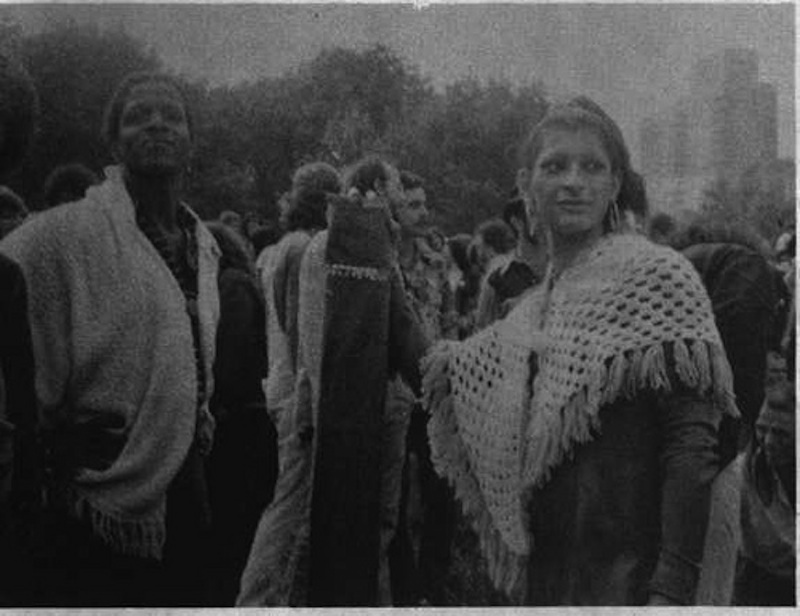
via Tumblr
Marsha P. Johnson & Sylvia Rivera, two trans women who created new imaginings of a future through their activism and participation in the Stonewall Riots
So sit with me a moment and meditate on these two familiar questions: what do you want to be when you “grow up?” What are you doing/do you want to do with your life? Sit with yourself, your love, your horrors, your victories, and your losses. Prioritize the answers to those questions that are not explicitly connected to a degree or career. Ask yourself these questions every day and all the time until you believe your failure. Your failure is usually the most honest parts of yourself.
We don’t all have the same “access” to failure, and you would most certainly have to bite me on the nose if I said so. Society gives some bodies more permission to contradict the norm than others. Unfortunately, until you and I, and all marginalized folks destroy Capitalism, we’ll probably need jobs and degrees to a certain extent. Also, I’m no televangelist and meditating on the aforementioned questions with me will not guarantee you a job or degree. However, I want to invite you to push against Society’s command to see yourself as worthy only when you serve the economic interests of the State. We’re taught that we must run from anything that is seen as “not-success,” even if that endeavor actually means standing still in the static of our own boring mediocrity.
Be mindful of the way you may compulsively sell yourself to others, of the embarrassed tone that may creep in your voice when you explain that you don’t have a plan yet, of the way you qualify what you’re doing with “just this job…” or “only that class…” Please be gentle with yourself always. In spite of what they may say, most humans are still in the process of searching for life. You are a beautiful, perfectly imperfect person whose worth is not monetary. Failure isn’t the enemy; fear of failure is.
Love,
A Fellow Failure
P.S. People with jobs, degrees, or both, let’s think of other questions to ask people than, “Where do you work?” or “When do/did you go to school?” They’re boring questions anyway, ok? Ok.
Say Yes to the Dress Recap: Brittney Griner and Glory Johnson
Feature image via ESPN
As I previously mentioned, my dreams of marrying Brittney Griner were cruelly shattered not too long ago. However, I didn’t want to be one of those bitter queer biddies who stitches 5EvaAlone patches into their tear-soaked flannel or who makes voodoo dolls of Glory Johnson (because homegirl is too fine for a spiritually-invoked retribution and I have a crush on her too). Brittney didn’t want that for me or you either. Fortunately for me, you equally heart-broken queers, and the ten additional cats I would have otherwise adopted to keep my company, Brittney and Glory understood our pain and gave us an episode of Say Yes to the Dress: Atlanta for us to cherish forever more, ’til death — or the end of television — do we part.
Season eight, episode ten of Say Yes to the Dress: Atlanta, which is aptly titled “Love and Basketball,” begins with all these basic store stylists preparing for their next assignment. When the head stylist announces that Brittney Griner is going to be at the bridal store, one of the stylists loses her shit. As do I.
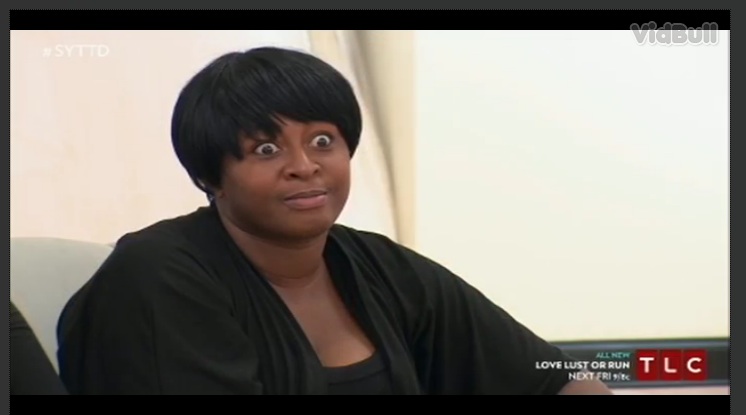
Be still my beating ovaries
Glory magically appears on screen and introduces her entourage of Unfriendly Black Hotties, including her infamous fiancée, Brittney Griner. Glory and Brittney explain the beginning of their epic romance: they played basketball in college as rivals. Glory won the first jump off and from that point on Brittney won everything else. Brittney’s like #SorryNotSorry and I can tell that this episode is going to be real competitive.
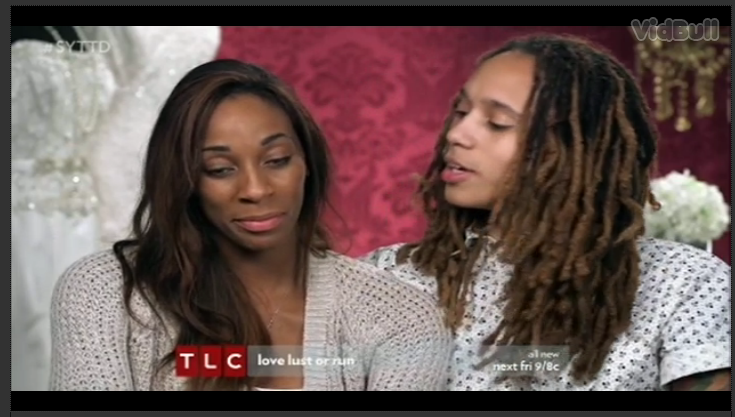
Glory is not amused by Brittney’s sass
Brittney admits that she was attracted to Glory from the get-go. Glory tried to resist Brittney’s charm and beauty but if that were possible, there wouldn’t have been a million heart-broken lady gays around the globe mourning (but still kinda celebrating) Brittney and Glory’s imminent wedding. The two began dating after college, and have been in rainbow bliss ever since. Glory explains that they’d like to go on a cruise that ends in Hawaii, where the two can legally marry in front of their loved ones.
This lovefest is short lived because they got twenty minutes of TV time to find Glory a dress. Brittney explains that she doesn’t know shit about dresses but that she wants Glory to wear a dress that shows off her body. I’m glad that Brittney is upfront about her dykey desires. She wants “more bride, less dress,” and all the queer viewers say, “Amen.” Glory’s sister takes it upon herself to offer the complete opposite direction for dress choices. Homegirl says that she’d like to see Glory in a dress that has a long train and Brittney looks like she’s ready to revoke homegirl’s right to an opinion.
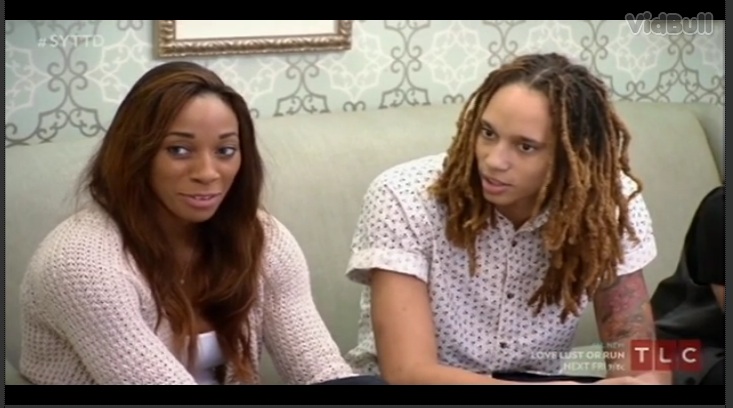
Ain’t nobody asked you what you think
This episode is high stakes and no one has even touched a dress yet. Glory announces, “We wouldn’t be true to ourselves if there wasn’t some competition. I’m excited to see who can pick out the best dress.” Brittney and her sister J forge Team Suits, while Grace and Judy, Glory’s sisters, form Team Dresses. After a few moments rummaging through dresses, Grace and Judy find a bunch of dresses that they think their sister will like. Grace has a clear advantage because she’s known Glory for always, identifies as a fashionista and confesses that “she likes a challenge.” In a different corner of the store, Team Suits have found nothing. The struggle is so real and I’m not actually sure why Team Suits were so convinced they would be viable competition. At one point, Brittney actually thinks she’s finally found a dress that works but after she sees Glory’s face, she is not so confident.
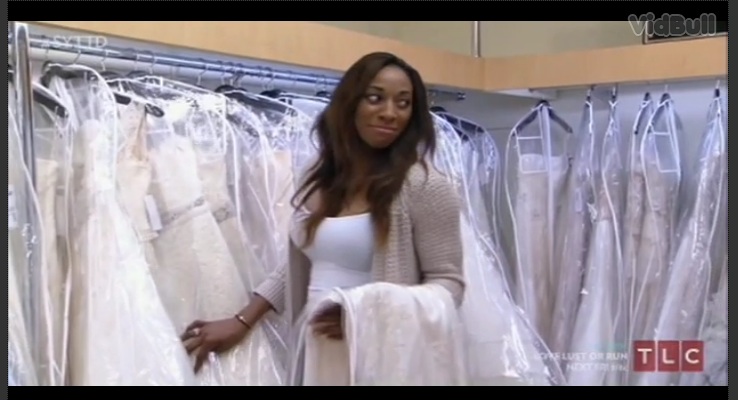
Bae… Do you know what a dress is?
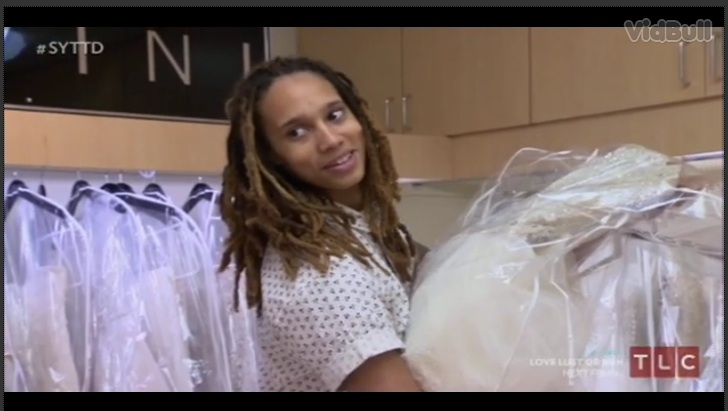
Uhm… I was just making sure you’re paying attention
Eventually Team Suits takes this mannequin hostage because why not? If the mannequin said yes to the dress, why wouldn’t the bride?
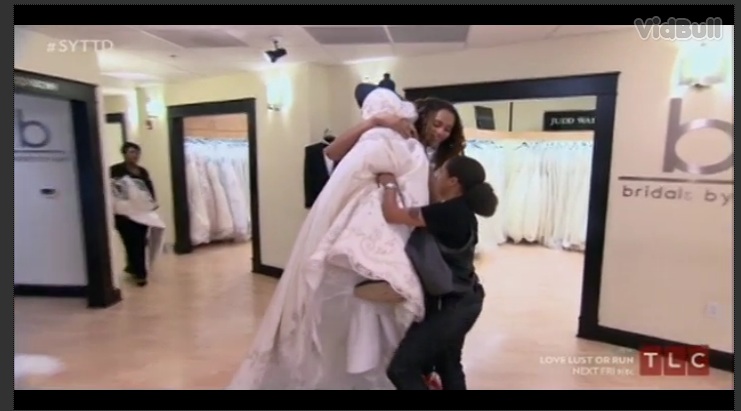
“I feel like the best dress would be on the mannequin because they want you to see it.” — Brittney Griner, SYTTD 2015
True talk though: there have been many times when I have been shopping and I really just wanted to take the mannequin’s outfit and call it a day. Given that Team Suits has not only found the perfect dress, but also have revealed the truth about capitalism and marketing, they take a break to do some catwalking.
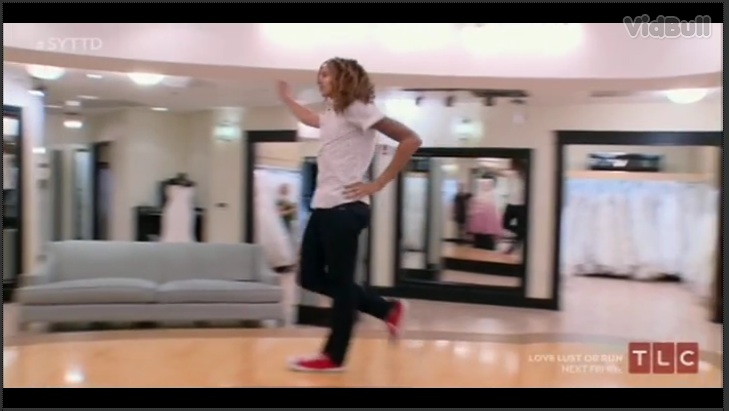
America’s Next Top Model presents: Gay and Gorgeous
The stylists decide to go with the dress Team Suits picked out first. Glory is surprised that she even likes the dress at all given that Team Suits barely know what a dress is and kidnapped a mannequin in the process of searching, but she debuts it for her entourage. At first, Glory is glowing and singing praises to the dress; Team Suits is really excited but Glory’s sisters disprove because it’s not form fitting below Glory’s waist. In Team Dresses defense, Glory and Brittney said that they wanted the dress to be form fitting but I also think Team Dresses were playa hating. Brittney and Grace are about to throw down and I kinda want this show to go all Jerry Springer for a hot second.
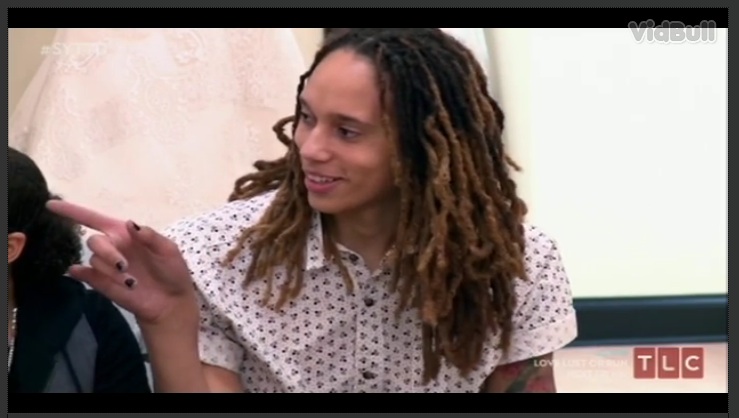
Brittney is about to come for homegirl’s life for dissing the dress
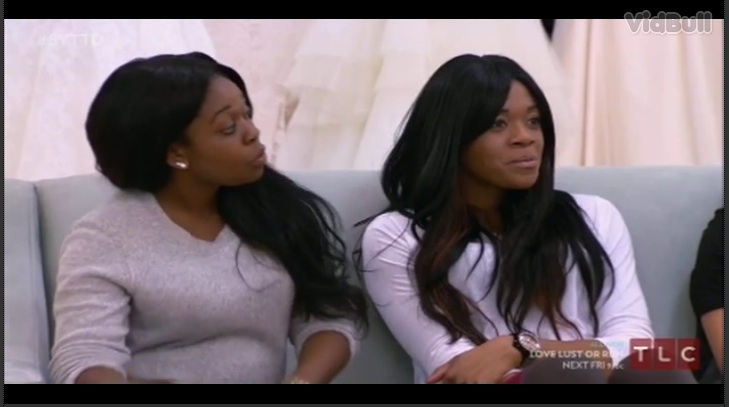
Grace ain’t even scared though
Before a fight breaks out, Glory heads back to the dressing room to try on the choice picked by Team Dresses. Glory is in love with this gown and even though she won’t say outright that her sisters won, she is definitely pleased. The dress is form fitting all the way down to her toes like Glory wanted, but when Glory shows the dress to the Unfriendly Black Hotties, Team Suits is not impressed. J says, “It looks like you’re going to an award’s show,” while Brittney argues that it doesn’t have enough bling. Glory changes her mind and agrees to look at some different options.
Fortunately, one of the store stylists is not as basic as the stylists on SYTTD tend to be, and she redirects the group. She tells them that while it’s great that everyone’s been having fun, the dress shopping is not a game and that it’s an important day for Brittney and Glory. The stylist advises Glory to try on a dress that she picked out, which — I think — is a healthy way to promote the bride’s autonomy and agency.
Glory tries on about four dresses by herself and begins to suffer from what I like to call Restless Fitting Syndrome or RFS. RFS is when I go shopping and I know I need to find an outfit that will serve a specific purpose, but after trying on almost every fucking piece of fabric that can fit me I start to get incredibly anxious and insecure. Suddenly, it seems like I either have to go home empty-handed — which I hate doing because I need to finish what I start — or I have to pick something that looks bad on me. Common symptoms of RFS are: sweating uncontrollably so you actually need to stop trying on clothes, a strong desire to start ripping, eating, or burning all clothes within a ten mile radius, desperately purchasing everything except the one thing you planned to buy, or writing manifestos you’ll never send to designers who can’t make clothes that fit bodies properly. The Unfriendly Black Hotties wait for 5 seconds in TV time, which probably correlates to 20 minutes in real time and 3 hours in what some Black folks affectionately refer to as CPT (Colored People Time). After a series of uncomfortable basketball puns, the stylists bring Brittney back into the dressing room to see if my former future wife can do anything to help her actual future wife.
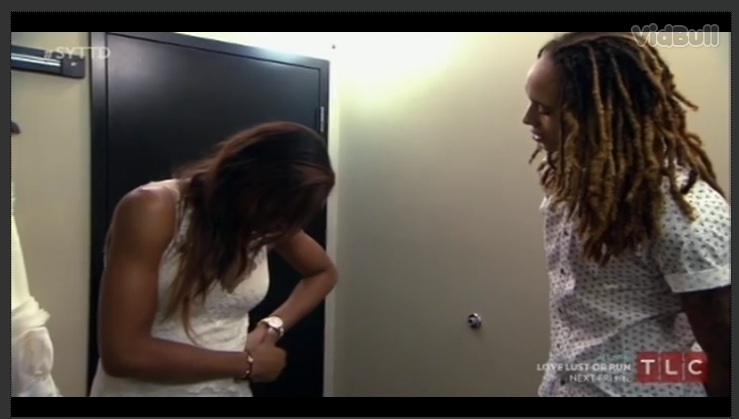
Brittney: “You’re not confident about how you look right now, huh?”
Our heroic lady gay, Brittney Griner, swoops in to boost Glory’s confidence. She reminds Glory that she’s beautiful and that she doesn’t have to keep looking at dresses that day if she doesn’t want to. Glory, like the champ she is, is not about to give up, and after a few cuddles and kisses from my — I mean her soulmate, Glory is ready to keep searching.
Finally, Glory emerges in dress #7, and she looks just as amazing and flawless as she looked in every other dress, except this time everyone admits that Glory is just a stunning human being in a gorgeous dress and we can die happy now.
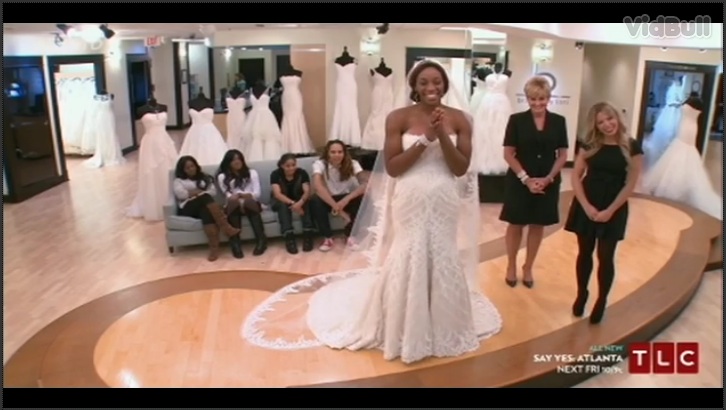
Beautiful ass human
Brittney is overwhelmed with all the feels and starts crying. The whole world weeps with her.
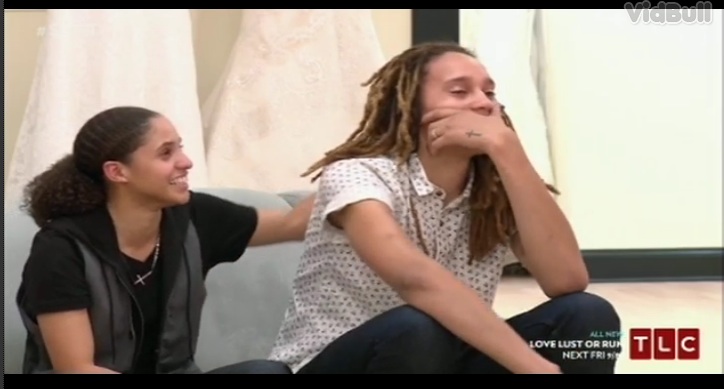
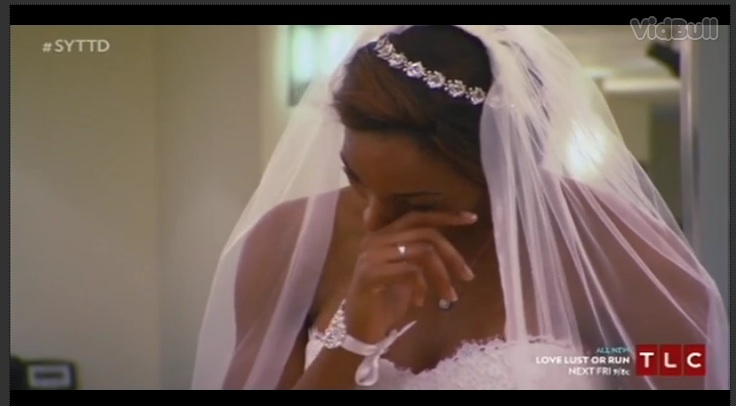
Do I have to upgrade to a certain level of queerness before I’m a cute cryer too?
Glory says yes to this dress and after all the tears and the happy feels, this woman brings it back to competition by announcing that she won. Swerve. I got so caught up in the tears and gayness that I forgot that Brittney and Glory made the dress shopping a competition. Let me tell you, this woman did win because she managed to get Team Suits and Team Dresses on Team Glory. After this episode, I’m sure she got some bitter ass queers making Glory voodoo dolls on Team Glory. This show is really Say Yes to the Glory and I’m 100% about it.
In conclusion, there are three important take aways from this episode of Say Yes to the Glory.
- Glory always wins. She foreshadowed it in the beginning. She won the first jump off between Brittney and herself. She won Brittney’s heart. She wins at life.
- If you suffer from RFS, just find yourself a lady gay to kiss your face and remind you that you’re a fucking goddess. Can we mandate this take away? Consensual lady gay kisses for all!
- Brittney Griner is the best would-be future wife ever for giving us, heartbroken queers, this episode to watch on replay whenever we miss her.
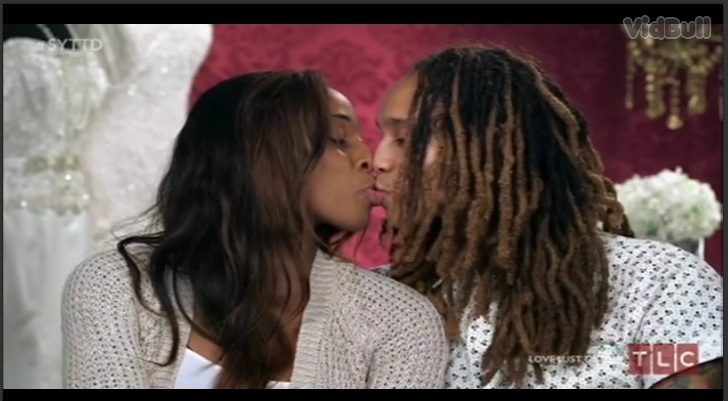
Consensual lady gay kisses to all and to all a good, queer life!
Say Yes to the Lez: The Five Best Queer Lady Moments on Say Yes to the Dress, in Brittney Griner’s Honor
On August 14th, 2014, I cried myself to sleep after finding out that the wifey of my dreams (and almost as importantly, a WNBA player) Brittney Griner officially got engaged to her beautiful and swoon-worthy WNBA player girlfriend Glory Johnson. Gone were my plans of sweeping her off her feet and slithering into the rainbow horizon on that giant-ass snake she charmed in 2013. I mourned for five months until the greatest news appeared on my social media: Brittney Griner and Glory Johnson are to appear on TLC’s “Say Yes to the Dress.” I know this is a gesture from my bae Brittney so that I can live vicariously through her and Glory. Brittney did this for all of us bleeding heart dykes. (But mostly she did it for me.)
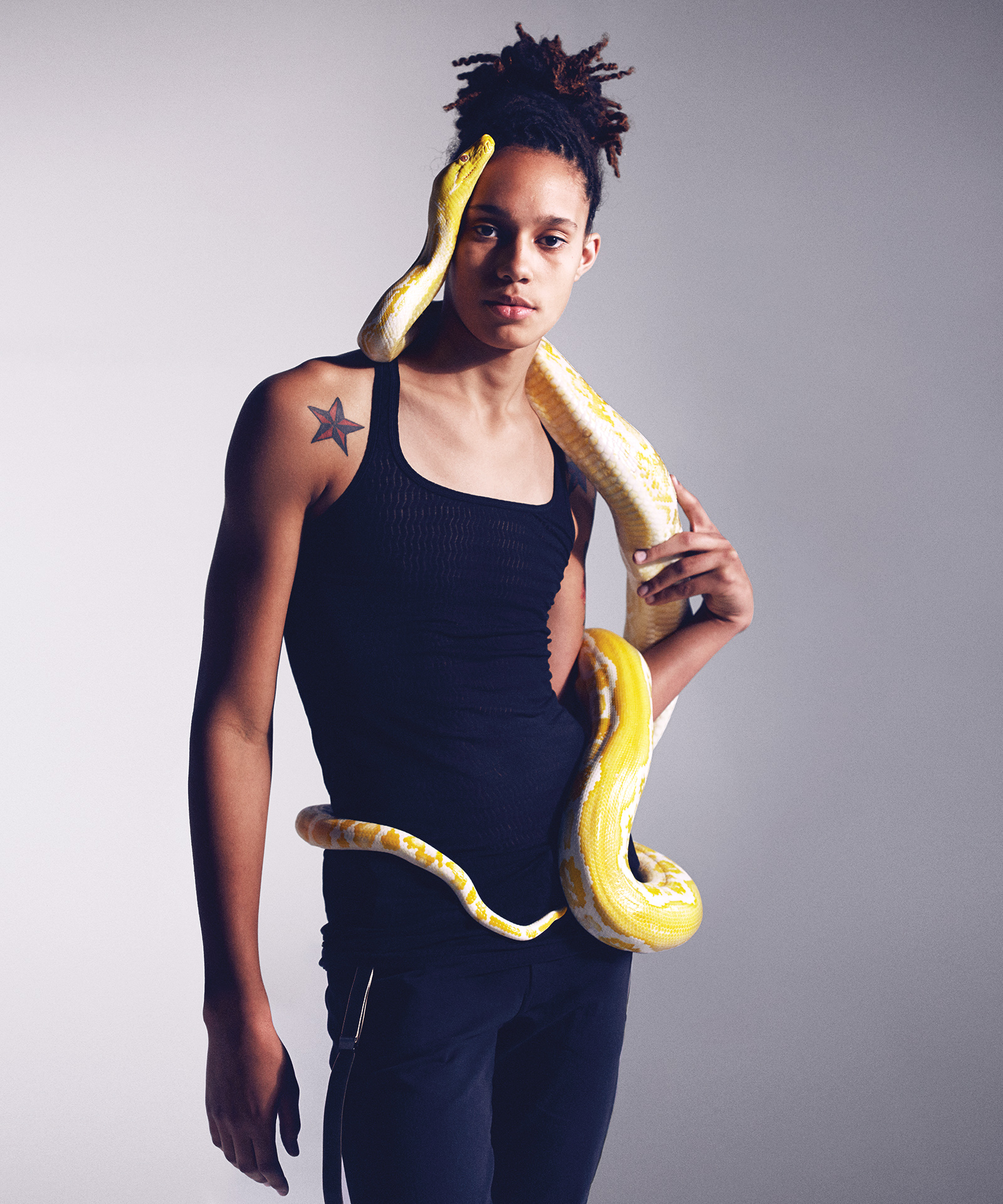
via AZ Central
We could’ve had it aaaaaaaaall. Riding on this snaaaaaake
For any and all who may not know, Say Yes to the Dress (SYTTD) is a show on TLC that follows people who are planning their wedding day and need to find their gown. This show is 20 minutes of stress and terror as this poor individual scrutinizes potential wedding attire and has her support systems evaluate and judge the quality of her choices. Although SYTTD is incredibly hetero-normative and hetero-patriarchal, it has been a really interesting platform for the visibility of queer women on television and narratives about marriage. Say Yes to the Dress is one of the few programs that captures the similarities and differences for all kinds of people preparing to tie the knot in this one snapshot of the traditional matrimonial process; its portrayal of queer women gives viewers the opportunity to see images of queer love in a “normalized” way, while giving us a glimpse into the uniqueness of same-sex relationships. So, whether you’re a giant fluff ball of wedding romance or are actually kinda disturbed/confused by the concept of marriage (like me, if I’m being honest), this shit can be pretty heartwarming.
In honor of Brittney Griner and Glory Johnson’s imminent SYTTD debut, let’s celebrate some lovely moments of lady gays past.
Erica and Devin
Erica and Devin were one of the first queer couples on SYTTD, making their debut in season five, episode four (“Going Bridal”). A great component of their episode was that not only did we get to see queer women preparing to say “I do,” but we got to see two feminine of center women in an interracial relationship loving one another. TLC understands what I need.
The two brides both found dresses, which is the happiest way this show can end. What I like a lot about their television moment is that they broke that rule the superstitious notion that you can’t see your spouse before your wedding day. The staff were surprised, but what kind of lady gay moment would it be if someone wasn’t pushed out of their comfort zone?
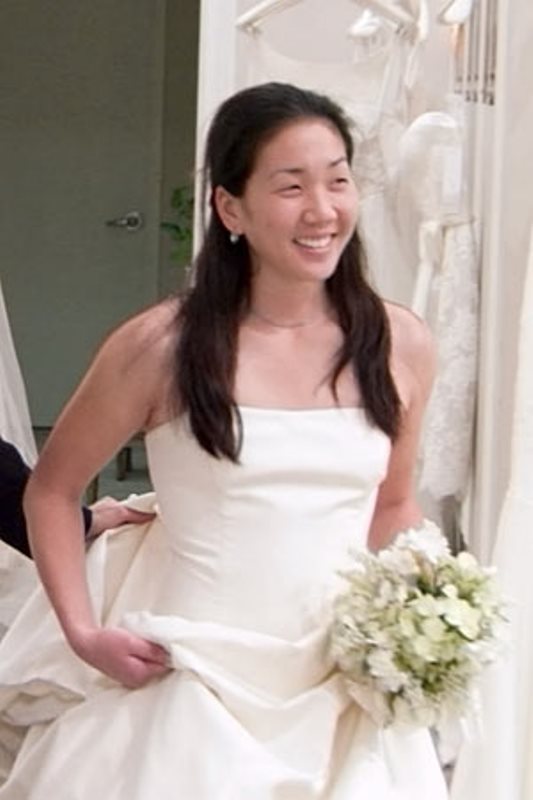
via The Fab Femme
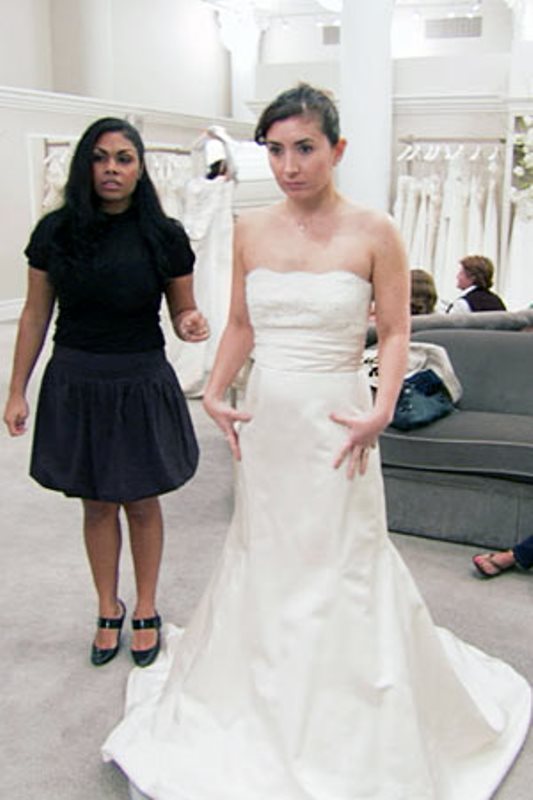
via The Fab Femme
Queen Precious Jewel Earth and Jacqueline
Season ten, episode thirteen of SYTTD featured Queen Precious Jewel Earth. Queen is a young woman marrying her partner of five years, Jaqueline (or J). Queen explains in the episode how important it is for her to marry her partner in spite of the fact that their union won’t be recognized unilaterally across the nation. “We’ll be married on paper in New York, and married spiritually in front of our friends and family in North Carolina,” she explains. I loved watching Queen search for the dress that would best compliment her as her mother and best friend supported her. As a gay Black woman, the support of other Black women has deep meaning for me and I couldn’t help but get teary as I saw Queen’s mother watch in awe of her child.
While this episode got me feeling some type of way, it also pissed me the hell off. SYTTD is terrible at treating fat women with respect. Queen explains that she underwent gastric bypass surgery two weeks before her fitting, and that she is en route to losing 100 pounds. The stylists spent her entire segment either whining about how long her name is or worrying that they wouldn’t have a dress big enough for Queen. The sizeism in this show can be really unsettling and heartbreaking; if marriage and a dazzling white gown is what someone wants to invest their money in, they should be able to get that no matter how skinny or fat they are. Even if the stylists were concerned that their store only catered to bodies the conform to Eurocentric standards of beauty, their grievance should have been directed at the fact that wedding gown sizes enforce fat-shaming and the policing of women’s bodies, not the brides. With that diatribe said, I recommend skipping over all the parts where the store biddies say words. Their opinions aren’t that important anyway.
In the end, Queen finds a dress that she loves, which makes me very happy. (There are episodes where someone does not get a dress because their size was not available.) Her mother is gushing and wonderful; her friend is not very amused and neither am I. In fact, her friend and I shared the same facial expression when we realized that this dress had a train of feathers and looked like it belonged in a Black Swan parody.

My thoughts exactly, girl.
But what really matters is that Queen felt empowered, sexy, and beautiful.
Davone and Tiffany
Davone wants to have a “platinum diamond winter wonderland” themed wedding, on season six, episode fourteen of SYTTD. I really like that she rolled into that shop knowing exactly what she wanted. She continues to describe her stipulations for the dress, explaining that she’d like it to be form fitting from her waist to her thighs and “drama at the bottom.” Although she and her partner Tiffany would like to have a “traditional” wedding — unlike other lesbian couples, Davone observes — this bride wants her dress to be peach. (I can’t lie; I love it when people disrupt the whole pure white dress aesthetic.) Davone does have a “problem” in her efforts though; she has to find a dress that can contain her large breasts.
https://www.youtube.com/watch?v=zdiZISL-RDw
Again, the store stylists are pretty awful at the way they regard her breasts, soooo… let’s pretend that they were not in this episode. I love how Davone’s friends were honest in their observations but very fun and supportive. “We need so much bling (on your dress) that we’re giving out sunglasses at your wedding,” one of her friends deadpans. By the end of the episode, I wanted not only an invitation to Davone and Tiffany’s wedding, but also the chance to turn up with Davone’s friends. Davone unfortunately does not get a dress for the silliest reason: apparently, some wedding dress designers refuse to allow alterations to the busts of their dresses. If I were Davone, I would’ve bought the dress she loved and found someone to alter it under the table. (Reason #9202492 why I most likely won’t get married.) But Davone gets another chance to shine on TLC when she’s featured in the show Four Weddings in 2012.
Amber and Anjeshia
I really enjoyed watching Amber and Anjeshia, two brides from South Carolina. The two actually were featured on Say Yes to the Dress: Bridesmaids, where the focus shifts to how individuals want to dress their altar entourage. Amber wants her friends to look sexy and to show as much skin as their hearts desire; Anjeshia, on the other hand, would prefer a more “classy” look for the bridesmaids, and definitely wants cleavage covered. While I think some of Anjeshia’s concerns extend to some internalized respectability politics, I see her perspective. It’s really important to Anjeshia that the wedding party can dance, because Amber and Anjeshia met while dancing. I would also want dancing to be a big concern in the outfit choosing process.
The two brides are both really opinionated, but Anjeshia takes the cake because she comes prepared with visuals. Anjeshia creates a chart called the Boob-O-Meter, and explains to the stylist that she would like the bridesmaid dresses to fall somewhere around a 7, with respect to cleavage visibility. Full disclosure: I couldn’t actually watch the entire episode through, so I have absolutely no idea who wins the Battle of the Breasts. But I do know that I will adopt a Boob-O-Meter for my personal life whenever I buy clothes. I think my aesthetic is 9 on the scale.
LaQuet and Lauren
These two are my favorite couple of the bunch. In “Not What I Had in Mind,” season 10, episode 12 of SYTTD, we meet LaQuet and Lauren, a Black lesbian couple who have been together for four years. Teary-eyed and describing her soon-to-be wife, LaQuet says Lauren makes her “feel like warm cookies straight out of the oven.” This episode makes me realize that I will change my mind and marry anyone who says this about me. (See, I told you this show does things to you.)
LaQuet spends most of this episode giggling and her joy is quite contagious. She’s a bubbly Broadway performer, and all she wants is a fun dress with some kind of sleeve so that the dress won’t draw too much attention to her toned arms. I’m not sure why she wouldn’t want to show off her muscles because I always thought muscles were the dyke badge of honor. The stylists agree with me and bring her dresses with and without sleeves. For the majority of her segment, LaQuet is disappointed by dresses she feels make her look matronly. In the end, she falls in love with a dress she thought she would hate and cries happy tears while we all bask in her beauty.
LaQuet and Lauren let us viewers see into their wedding at the end of the episode, which is an awesome choice. I love seeing queer women, especially queer women of color, happy and loving one another. More importantly, the theme of LaQuet and Lauren’s wedding is “drunk, tanned, and married” because “that’s just how much fun we’re gonna have.” I’m telling you, the lady gays on this show are so much fun.

via ElixHer
SYTTD is a great guilty pleasure show because it lets you celebrate with people experiencing what they may consider one of the happiest moments of their lives. Also you don’t actually have to question if you’re making the right decision about what you’re wearing while you watch the show. Personally, I love watching people make decisions that have no claim over my life.
While SYTTD is by no means a perfect show, nor does it necessarily communicate the various perspectives and aspects of marriage, I think it’s a fun show. I have no qualms engaging in a program that offers one of the healthier images of queer lady love.
Make sure you catch Brittney Griner, Glory Johnson (and my) Say Yes to the Dress episode this Friday, January 30th at 10 p.m. EST on TLC!
Communities, Not Police, Are Our Best Bet for Ending LGBTQ Domestic Violence
feature image via purposefully scarred
On December 2nd, 2014, medical rescuers found Pamela Donahue dead in her apartment in Providence, RI. It took three weeks for police officers to charge her girlfriend, Sendra J. Beauregard with Donahue’s murder in spite of reports that Beauregard and Donahue had been heard arguing for weeks, Beauregard and Donahue had been together in the apartment before the homicide, and police had responded to calls that a woman had been standing outside of the apartment the night before, screaming that she was “going to kill someone.”
Unfortunately, Donahue was not the only woman killed due to same-sex domestic violence-related homicide in 2014. In October, police named Victoria Mendoza as a suspect in the murder of her girlfriend, Tawnee Maria Baird. In addition to Donahue and Baird’s murders, other queer women like Alejandra Leos, Britney Cosby, and Crystal Jackson lost their lives to domestic violence. Leos, a transgender woman of color, lost her life when she was shot outside of her home in Memphis, following a domestic dispute with her killer, Marshall Pegues. Concerning Britney Cosby and her girlfriend Crystal Jackson, police suspected Cosby’s father with the homicide earlier in the year. This laundry list of domestic violence-related murders of queer women is not a new phenomenon, nor does it truly comprise the extent to which domestic and intimate partner violence impact queer, female communities.
We’ve talked about how bad domestic violence is and in 2014, the National Violence Against Women survey published that “35.4 percent of women living with a same-sex partner experienced intimate-partner physical violence in their lifetimes, compared with… 20.4% for… women… with a history of only opposite-sex cohabitation.” The CDC even re-released its National Intimate Partner and Sexual Violence to show how domestic violence impacts LGB folks. With respect to women, the study found “the lifetime prevalence of rape, physical violence, or stalking by an intimate partner was 43.8 percent for lesbians, 61.1 percent for bisexual women, [versus] 35 percent for heterosexual women.” These studies clearly can’t take into account that the majority of domestic and intimate partner violence cases will remain unreported to surveys and especially to law enforcement. We know that domestic violence is a reality for far too many members of our communities, and yet we keep losing our queer family to abuse.
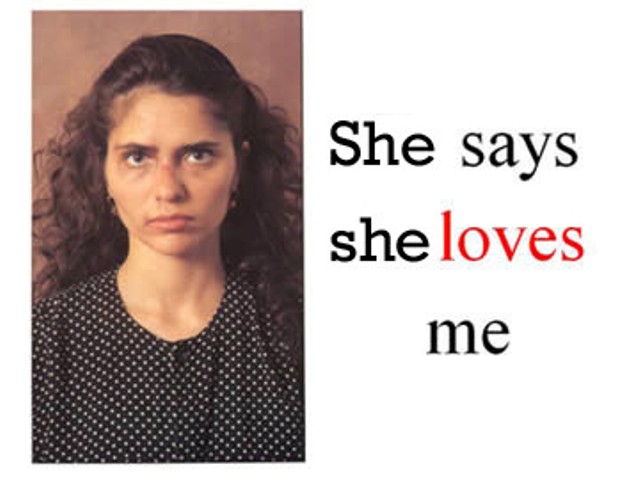
via Examiner
Ultimately, it’s a victim/survivors*’ prerogative whether they stay in or leave an abusive relationship; however, not all victims get a choice. Queer women face many of the same barriers that straight folks in abusive relationships face, like increased violence upon leaving the relationship or living in a society that readily values the abuser’s side of the story more than the victim/survivor’s. An on top of that, queer women encounter additional societal barriers to protection. Judges and law enforcement personnel don’t always enforce protection orders for queer women due to misogynistic assumptions that women aren’t really that dangerous. Additionally, according to a 2007 Department of Justice study, police are 30 times more likely to arrest both partners when a report of intimate partner violence involves a same-sex couple. Not only does that put the victim/survivor in increased danger, but it may prevent victims/survivors from accessing services from domestic violence organizations who don’t or can’t serve people with criminal records. Moreover, not all queer women are out, and coming out in order to prosecute an abusive partner may make them more vulnerable to victimization by employers, housing authorities, family, or communities.
I think the saddest aspect of these murders, the murders that will inevitably take place, and the violence that will go unnamed is the silence. After Tawnee Baird’s murder, the young woman’s family mourned that they did not recognize the potential signs of abuse sooner. Her dad noted that he had seen Tawnee with a front tooth missing, and her girlfriend with scratch marks across her face; the couple insisted that they had been attacked at a party. Even more heartbreaking for her family, Baird’s parents later heard from the victim’s friends that Baird had lived in fear of her girlfriend. In the September case of an unnamed victim, whose girlfriend, Maya Shelia Moore, stabbed her multiple times before fleeing the scene, the victim had told police that Moore had attacked her in two isolated incidents before the almost-fatal stabbing. We can only guess that the people in these women’s lives tried to help in one way or another. It’s important to remember that bystanders really can help people experiencing domestic violence to leave an unsafe relationship, or at least find safer ways of staying if they cannot flee.
Victims/survivors in general are expected to seek help from law enforcement to escape from abusive relationships, but the police are sometimes the most dangerous and threatening forces in the lives of marginalized folks, even those who have an abusive partner, friend, or relative. This concern is compounded when a victim/survivor belongs to a group that already faces the threat of danger from the police, like being a person of color or sex worker. For that reason, community support is central to assisting victims and survivors of domestic violence. Domestic violence is a community issue because of the way violence tends to affect people intergenerationally and cross-culturally through the cycle of abuse. Particularly in the LGBTQ world, we individuals tend to impact our communities because we often create tight-knit bonds in order to survive. If and when abuse occurs in our communities, it impacts our mentors, our peers, our chosen family, and ourselves. When people in our communities are unsafe, we are all unsafe.

via SCMP
We need to look to our history and herstory when we think about ending domestic violence and aiding victims/survivors. Feminists, activists of color, and queer folks used grassroots organizing to better their communities, particularly from the early 60s to the 80s (but all throughout the course of time, really). In the mid-80s, Sue Knollenberg, Brenda Douville and Nancy Hammond of The Task Force on Violence in Lesbian Relationships described inclusion of same-sex attracted women in the domestic violence movement. In their piece, “Community Organizing: One Community’s Approach,” they explained how feminist therapists provided an important resource for female victims/survivors until self-help groups were forged. It was essential to utilize the services that allies and marginalized folks in their communities could offer. Furthermore, also in the mid-80s, an anonymous organization wrote in a piece called “Organizing Safe Space for Lesbians: A Community Based Program” about their strategies:
“We organized community meetings throughout the extended lesbian community in our area… Where we knew there were lesbian gathering places or supportive “peoples” places, we posted flyers. In scary areas, we used phone calls and word of mouth. At community meetings, we made a basic educational presentation titled ‘Violence in Our Lives.’ We defined physical, emotional, sexual, and societal violence. We explained the dynamics of victimization and better behavior, how violence escalates, lethality, the effects on our community, the difficulty of breaking the silence, the effects on children, confidentiality, what you can do if you are a victim, a batterer, or know someone who is and what lesbians can do about violence in our communities. We shared current resources, our goals, and then opened up the presentation to lots of questions and discussion.”
Domestic and intimate partner violence prevention are communities’ duties, not the burden of victims and survivors. It is also important that victims and survivors are given the space to guide and direct these prevention tactics and the movement at large. The Lesbian Abuse Issues Network (LAIN) said in 1986 that “the lesbian/gay community as a whole seemed quite concerned about street violence against its members, but domestic violence within homes and relationships seemed off limits” (“Community Organizing”). It’s really hard to talk too loudly about domestic violence in LGBTQ communities because quite frankly, it makes us look “bad.” We have to acknowledge that the heteropatriarchy still wreaks havoc on our families and relationships, and that we find, hide, and sometimes even foster abuse in our own communities. The amount of time we spend talking about same-sex marriage, Beyoncé, and sex positivity can also be spent educating our young queers on healthy and safe relationships, on developing batterers’ intervention, and getting victims/survivors the resources they need. Furthermore, we must educate bystanders on how to best support victims/survivors of domestic and intimate partner violence, because silence is complicit in violence. We cannot just assume that if someone is in trouble that they will call the police or find a shelter, or that these options will be open to or helpful to them if they do. Legislative advances like the inclusion of LGBTQ folks in the Violence Against Women Act have definitely increased the resources that queer, female victims/survivors can access, but it does not necessarily help queer women flee abusive relationships or stop the violence from taking place.
We must see our communities as having a greater stake in the safety of our queer siblings. I refuse to settle for statistics and sad news stories. Community response and action is the foundation of survival for marginalized communities, and it always has been. I truly do believe that some day domestic violence can be eradicated, but ending domestic violence begins with collective solidarity.
*Victim/survivor: I use both terms because legally, depending on how recent a case of domestic violence has occurred to an individual, the legal system regards the individual as the victim. But I think self-identification is more important than legalities so I offer the term “survivor,” for those who identify in that way. “Victim/survivor” is a compromise for both forms of identification, which serve their own purposes in various contexts.
Top 10 Queer and Feminist-y Moments of Degrassi Season 13
Feature Image via Degrassi Wiki
Season fifty-eleven gazillion of Degrassi: The Next (Next Next) Generation kicked off last week. Before we get too far into bisexual cutie pie Imogen’s last semester in the show, we figured we should take a look back at last season. So welcome to Degrassi High, where every student gets cancer and there are too many spontaneous musical numbers for the characters to be as straight as they claim to be. Even though Degrassi killed off our favorite trans character, Adam Torres, the show made an attempt to appease the queers with some lesbian action, a touch of female empowerment, and a handful heteros with queer ambitions. Without further ado, here are the top 10 queer and feminist-y moments of Degrassi season 13.
10. Drew’s mom gives us a lesson on treating women with respect
Remember Drew Torres? So-called lady killer, champion of heterosexuality and stereotypical masculine chest thumping, and somehow the school president as of last season? The most interesting thing about Drew for the last few years — as far as I’m concerned — is that he is (or was) Adam’s older brother and gave producers an excuse to give Adam more screen time.
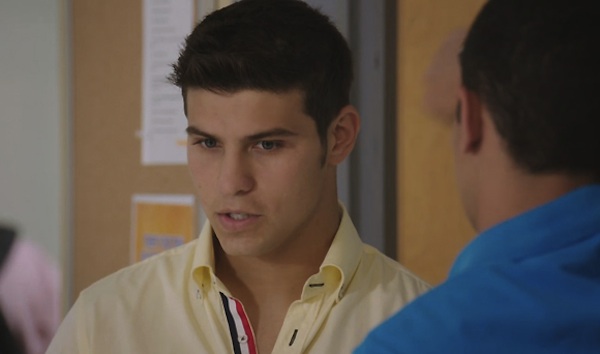
via MTV Canada
Am I really that irrelevant now?
Fortunately, Drew decided to get some ambition in his senior year by becoming a leader in the student council, and getting an internship with a douchey mayoral candidate. Even though he says he’s taking a break from women, we all know that on Degrassi, life decisions only last two minutes of real world time and one episode of screen time. Obviously, he starts dating a sophomore named Zoë Rivas after an outfit change.
In an attempt to stay true to his no-dating commitment, Drew claims that their relationship is casual and has sex with Zoë in a pool house to prove it.
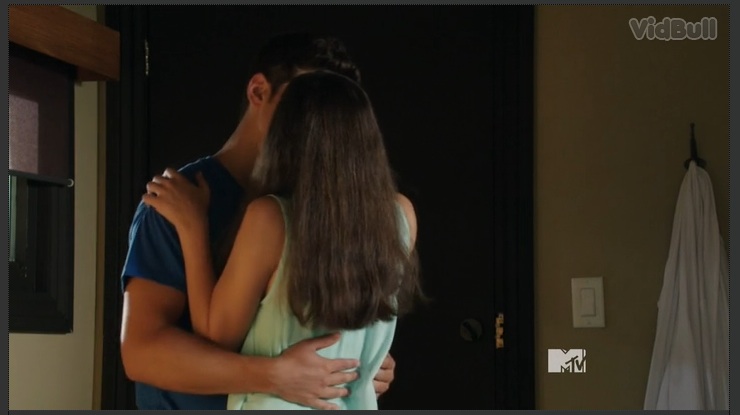
Zoë is not amused that Drew tells her post-sexy time that he wants to be casual, especially since their pool house dalliance was her first time having sex and she thought it was special. Zoë tells her mom that Drew is an asshat and Mama Rivas confronts Drew at a public Q&A session with the mayor that Drew is hosting for his internship. Awkward! The mothers and ex-casual-not-casual-pool house-frequenting lovers meet with Principal Simpson, who is probably the worst person to use as a conflict mediator and who helps resolve this conflict in no way. Drew faces no punishment because technically his pool house adventures were not statutory rape in Canada thanks to “close-in-age exceptions” in the law.
But when Drew gets home his mom is like, “Sike! I hate men like you!” She tells Drew that it’s important for him to be aware of why he’s having sex with someone and that it’s fucked up to use someone for sex.
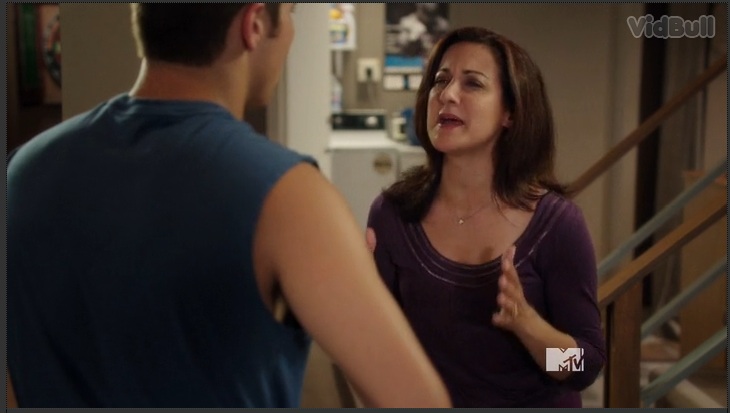
“Sex is serious especially for a girl, especially at that age. You did a dumb, selfish, insensitive thing.”
Her reasoning isn’t perfect, but thanks, Mama Torres, for educating your son. He needed to have several seats.
9. Clare joins a coven of dykes
Clare Edwards is yet another champion of heterosexuality, most often associated with former emo-kid/current NYU student Eli Goldsworthy. After the most yo-yo hetero relationship I’ve seen in a while with Eli, briefly dating her step brother, and then falling for Drew (I call witchcraft on this kid’s pheromones), Clare decides to focus on herself by training for a triathlon.
Who else would be the triathlon coach but new student, pot smoking dancer, and our resident Lady Homo, Jack. Jack sees straight (heh) through Clare’s struggle.
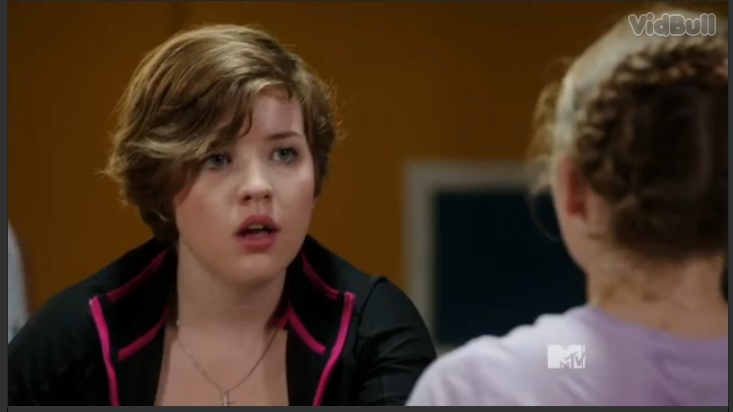
OMG a real lesbian sweating before me!
Jack: Lemme guess, just broke up with a guy and now you’re here to get fit.
Clare: Two guys actually. And my friends seem to have zero interest in hanging out with me.
Jack: Women.
Jack tells Clare to hang out with her and her friends for a better time, and take Clare … AXE THROWING!?!
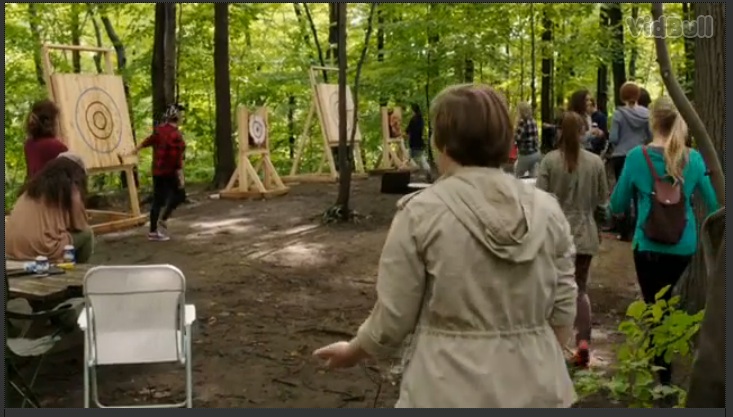
Clare: What is this?!

Jack: Backyard axe throwing week, duh.
Aka the gayest shit I have ever heard of. Let’s take a moment of silence for all of us women in the U.S. who did not know that in Canada y’all throw axes for fun, and who are now contemplating crossing the border. I can’t be the only one whose world was rocked this hard by axe throwing.
Jack offers Clare some really beautiful advice in this episode which I hope Clare takes to heart:

Casual flannel, casual beer toss.
“Take boys out of the picture and the whole world opens up.”
Jack’s raging misandry is a breath of fresh air, but proves too overwhelming for Clare, who feels the need to come out as straight at the end of the episode. Jack says they can still be friends, adding, “You’re a cool girl Clare, even if you’re a hetero.” Imogen better marry this woman or I will hop into the TV and marry Jack myself.
8. Imogen fights the system with feminism?
One of Degrassi‘s most consistent queer ladies is awkward heartthrob Imogen Moreno. She shows up to her French class late and is forced to make her presentation on Celine Dion as soon as she runs in the door because high school sucks. Imogen, in her rush, forgot to wear a bra, which is definitely not scandalous in my world. But, this douche-canoe named Luke starts making fun of the fact that everyone can see Imogen’s nipples. The French teacher pulls Imogen aside in what we hope will be a moment of breasted-people solidarity, but instead she tells Imogen that she’s distracting the class — which would’ve happened even if Imogen were wearing 20 bras because homegirl is a cutie — and needs to leave until she gets a bra.
In a meeting with conflict-resolving-failure Principal Simpson and Madame Brassiere, Imogen rightly complains that kicking her out of class for wearing no bra is sexist and irrational. Simpson concedes that nothing in the school constitution states that a student with breasts needs to wear a bra, but mentions that said constitution has language about community standards. Imogen is like fuck the noise! and uses her school television department, Degrassi TV, to shame the administration. She wears her bra over her shirt so that everyone will know her boobs are covered.

Simpson is mad as hell because boobs are scary and other breasted-folks are following Imogen’s lead. He’s also mad because Imogen takes her complaint a step further by pointing out that the dress code specifically aims to control female students’ appearances.

Simpson says that Imogen gets to decide how to amend the dress code, which is a harder task than Imogen anticipated. Imogen’s friend Becky spends most of this episode’s plot murmuring some respectability politics-informed feedback that we all ignore. Fortunately, Imogen tells Becky that the problem with dress codes is that they limit the creative self-expression of all people, and that the solution isn’t just forcing male students to wear tutus or stop wearing their pants low. After some questionable statements about feminism and what Gandhi would do, Imogen proposes a new dress code where students can wear whatever they want as long as their intention is not to distract other students or to disrespect themselves. I’m not exactly sure how the administration plans to enforce this, and the language of “disrespecting themselves” seems like it might lead to some problems down the road; but Degrassi‘s knack for continuity is only a little better than Glee‘s, so I don’t think anyone will be inconvenienced by the dress code for another 14 seasons.
7. Grace is a character
Grace Cardinal has to be the best secret homo sidekick since Alex Nuñez (seasons 3-6). She rocks blue hair and numerous piercings, confronts her male friends when they say problematic things about women, is not afraid to call people out for treating the students in remedial classes like trash, and helps expose two students who sexually assaulted Zoë Rivas (more on that to come).
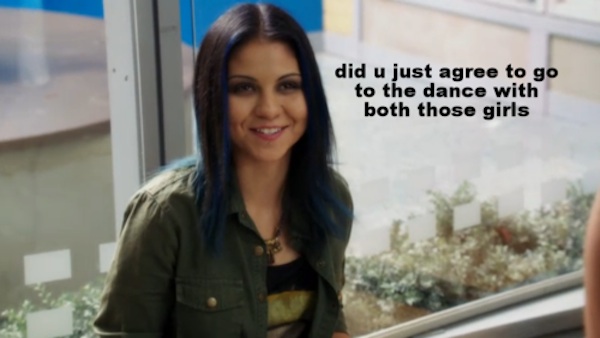
via Tumblr
Grace understands the queer struggle and pities you not at all
Grace has not gotten a plot of her own, but she is a nice contrast to sidekick characters like Connor or Winston (aka Chewy), who literally spend seasons making white characters feel better about themselves before they get any kind of development. Grace isn’t a stand alone character yet, and we don’t learn why she is placed in the “Rubber Room” for remedial classes, but I think she shows potential. Also, everything about her screams baby queer to me so I am excited for her to embrace her lady-loving feels someday. And, if the producers decide to kill or write off the queer ladies (again), we may have a survivor!
6. Becky tries to be gay
As a former conservative Christian/misguided biddie, I sympathize with Becky’s struggle. Except I’m actually gay but that’s a different story. Becky Baker became a somewhat decent LGBTQ ally when she started dating Adam Torres, but maybe we hate her because she killed Adam. (Okay, no she didn’t but she may as well have.) Without a boo, she doesn’t really have anyone at school to call a friend until she bonds with Imogen. They have all the BFFL feels until Jack transfers to Degrassi mid-semester and mid-season. Imogen tries to do the thing where you’re totally into that cute lady and you’re 85% sure she’s queer, but you don’t know how to flirt so you ask said potentially queer person to spend all of their time with you and your friends while you try to find out how they identify and learn how to flirt. Becky is not amused because she knows about the lesbian merge and doesn’t want to lose her new BFFL.
Becky makes mistake number one and asks Drew for advice. Drew’s like “Have a ladies night,” which theoretically could’ve worked if Becky didn’t ask Imogen to go to Degrassi’s Sweethearts semi-formal dance with her so that the two could get to know each other more “intimately.” Becky goes back to Drew for advice, because as a man and as the straightest dude ever he must know about queer women. Drew advises:
“You could become a lesbian. Or pretend to be a lesbian.”
And that’s how MTV came up with the idea for Faking It.
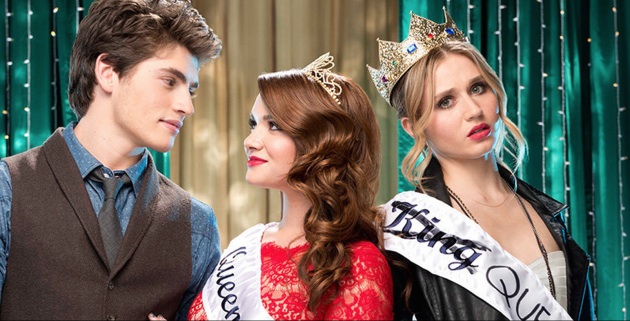
via Project Casting
Jack is not amused when she finds out that Becky is jacking her swag and tells Becky to do better.
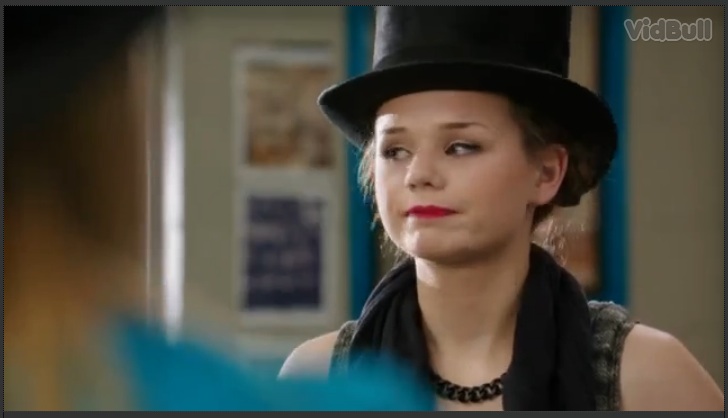
This is why I hate straight girls…
Jack: “But you’re not gay…”
At the semi-formal, Becky and Imogen slow dance for a hot second and then Becky also comes out as straight. When Becky blurts out that she can’t be a lesbian, Imogen is actually really happy.
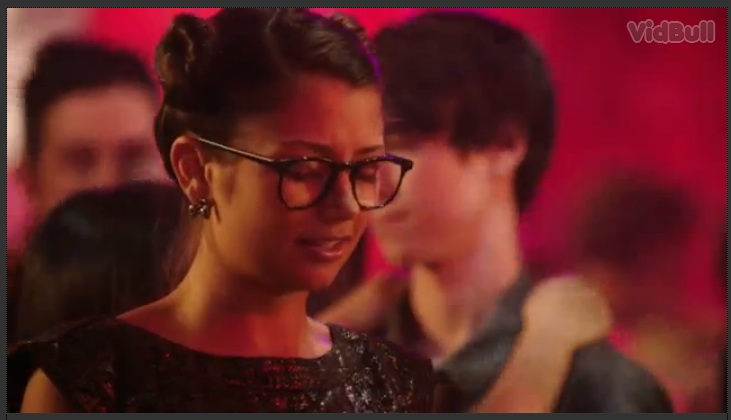
She was clearly praying to the queer ancestors that no one actually shipped her with Becky
Imogen: Oh thank goodness!
Becky: Why? Because you already hate me?
Imogen: No, because you’re my first girlfriend at Degrassi that isn’t my girlfriend. Fiona and I used to be inseparable but now we barely talk.
#LezzieTruths
#BeckyTried
Slowly but Surely, Gay Conversion Therapy Is Coming Out of Mental Health Practices
Feature image via Global Post
Many of us have been following the news of states that are legalizing same gender marriage, but a few states are joining the battle for a different legal trend that will benefit LGBTQ people. We told you about legislation in California and effort in New Jersey to prohibit mental health professionals from administering gay conversion therapy to individuals. Although the American Psychological Association asserted in 2007 “that efforts to change sexual orientation are unlikely to be successful and involve some risk of harm,” California and New Jersey are leading the way as the only two states with laws prohibiting licensed therapists from performing gay conversion therapy on individuals under the age of 18. When the New Jersey and California courts ruled on the matter, New Jersey’s Third Circuit Court and California’s Ninth Circuit Court both decided that states do have the authority to govern the conduct of professionals. However, while the Ninth Circuit Court also stated that conversion therapy ban applies to speech, the Third Circuit Court differed and said that its protection of speech held less force because “Plaintiffs are speaking as state-licensed professionals within the confines of a professional relationship.” Opponents of the legal movements to eliminate reparative therapy treatments argue that a ban against conversion therapy infringes on mental health professionals’ right to free speech under the First Amendment and their religious beliefs. Now, New Jersey opponents have found hope in the loophole of the Third Circuit’s rationale and are planning to ask the Supreme Court to hear an appeal next week. (California opponents also tried to make a case for an appeal but the Supreme Court didn’t want to hear it.)
Gay conversion therapy, also called reparative therapy, was brought to prominence by our friend Sigmund Freud, who was a really big fan of psychoanalysis. He suggested that, with the help of hypnotic suggestion, homosexuality could be removed from an individual. Ultimately, a 1909 visit to the United States, where Freud gave a series of lectures at Clark University about psychoanalysis, gave his beliefs traction in the land of homos and group fear. Even though he suggested that homosexuality could be eliminated, he didn’t really think that homosexuality needed a cure. He even tried to persuade an American mother, in a 1935 letter, that her child’s sexuality should not distress her. He wrote:
“Homosexuality is assuredly no advantage, but it is nothing to be ashamed of, no vice, no degradation, it cannot be classified as an illness; we consider it to be a variation of the sexual function produced by a certain arrest of sexual development. Many highly respectable individuals of ancient and modern times have been homosexuals, several of the greatest men among them (Plato, Michelangelo, Leonardo da Vinci, etc.). It is a great injustice to persecute homosexuality as a crime, and cruelty too. If you do not believe me, read the books of Havelock Ellis.”
After Freud’s death in 1939, however, and before the 1969 Stonewall riots, theories about gay conversion therapy gained a lot of momentum and most psychiatric establishments in the U.S. supported the notion that psychoanalysis could cure homosexuality.

Freud is judging you
via Wikipedia
It’s unfortunate that it has taken more time to convince people that gay conversion therapy is real and incredibly harmful than it took some truly misguided theorists convince people that gay conversion therapy could eliminate homosexuality; but, in spite of the federal government’s failure to condemn this brand of therapy, lawmakers from various states and the federal district are following in California and New Jersey’s footsteps to change mental health practices for the better and end a practice that has haunted LGBTQ communities throughout the nation. Minnesota, Michigan, Ohio, Pennsylvania, Massachusetts, Vermont, and Washington D.C. all have active legislation to institute bans against reparative therapy. In D.C., proponents say that council members will take action in October to mark up a proposed bill that would prohibit mental health professionals from performing gay conversion therapy on minors, and hope that we could see a law passed this fall. D.C. Council Member Mary Cheh (D-Ward 3) argued against gay conversion therapy, insisting:
“These so-called therapies are not based in science, they have been denounced by nearly every major mental health organization in the country, and they can exacerbate the associated psychological effects and anxiety a young person may feel when coming to terms with his or her sexual orientation. I am glad that the District is at the forefront of the introduction of such bills, and I expect and hope that other state legislatures across the country follow suit.”

via NCL Rights
Elsewhere, lawmakers are waiting until the January lame-duck session to promote anti-gay conversion therapy bills. Adam Zemke, Michigan State Representative, introduced legislation in July that would institute a statewide ban, but in spite of the bill getting stalled, he plans to garner bipartisan support until he can bring the bill before the House again. Even in states where proposed bills failed, lawmakers are far from giving up. New York and Illinois have met some difficulties in advancing legislation, but Illinois state representative Kelly Cassidy says she is planning to reintroduce the bill in January and advocate for more understanding of the issue across party lines.
This move to prohibit the use of gay conversion therapy has the potential to really change the lives of LGBTQ folks in the United States. By establishing a limit for professional conduct in mental health fields, lawmakers are taking power away from a realm that has systematically stigmatized queer communities. As Senator the author of the California anti-conversion therapy legislation, Ted Lieu, asserted, “Not only does conversion therapy not work, but it can result in suicidal thoughts, actual suicide, guilt, depression and shame.” Work towards providing legal prohibitions against reparative or gay conversion therapy is crucial to LGBTQ movements because it ensures the emotional, spiritual, and often times physical well-being of members of our communities. Studies have found that LGBTQ youth experience higher rates of mental health challenges and health problems associated to those challenges than their heterosexual peers; given that our communities often times struggle at such a high rate with mental health complications, we desperately need a medical system that does not promote the biases of a heteronormative society. Anti-conversion therapy legislation help to protect legally our queer siblings. If these bans on mental health practices gains as much momentum as the battle to legalize same-gender marriage, we could see many states striving to protect the mental health of LGBTQ individuals by 2015.
The NFL’s New Stance on Domestic Violence Isn’t a Step in the Right Direction
Feature image via Locker Room Picks
On August 28th, NFL Commissioner Roger Goodell issued a letter to all 32 NFL owners apologizing for his shitty response to a case involving domestic violence, and promising a newfound commitment to advocating for domestic violence and sexual assault prevention. Goodell’s shift comes after weeks of public outrage in response to the commissioner’s decision to suspend Baltimore Ravens running back Ray Rice for only two games after after Rice received a simple assault-domestic violence charge. (In February of 2014, police charged Rice with simple assault-domestic violence for beating his fiancée in Atlantic City). This new change in tone also followed several discussions between NFL officials and experts in the fields of domestic violence activism and sexual assault prevention.

Roger Goodell shimmering with the glow of domestic violence prevention
via Modvive
The commissioner outlined the following six measures that the NFL will take to update its policies.
One: Education for rookie and veteran players about domestic violence and sexual assault.
Two: Club Player Engagement Directors, Human Resource executives, and other team officials will receive training so that they can better identify and help players who are at risk of engaging in or experiencing domestic violence.
Three: The aforementioned training will also be offered to NFL LifeLine and NFL Total Wellness program staff.
Four: The educational components of the NFL’s domestic violence and sexual assault prevention initiatives will extend to the NFL’s college, high school, and youth football programs.
Five: The NFL will endorse domestic violence and sexual assault awareness and prevention programming in its public service work.
Six: “If someone is charged with domestic violence or sexual assault there will be a mandatory evaluation and, where professionally indicated, counseling or other specialized services. Effective immediately, violations of the Personal Conduct Policy regarding assault, battery, domestic violence or sexual assault that involve physical force will be subject to a suspension without pay of six games for a first offense, with consideration given to mitigating factors, as well as a longer suspension when circumstances warrant. Among the circumstances that would merit a more severe penalty would be a prior incident before joining the NFL, or violence involving a weapon, choking, repeated striking, or when the act is committed against a pregnant woman or in the presence of a child. A second offense will result in banishment from the NFL; while an individual may petition for reinstatement after one year, there will be no presumption or assurance that the petition will be granted. These disciplinary standards will apply to all NFL personnel”
In his letter, Goodell explained “These steps are based on a clear, simple principle: domestic violence and sexual assault are wrong. They are illegal,” stating the obvious for anyone with a basic understanding of human rights.
The National Network to End Domestic Violence (NNEDV) — one of the organizations that has worked with the NFL for this change — commended the NFL’s Action Plan. “Commissioner Goodell acknowledged his mistake, took ownership of it, and is determined to make the NFL a model for the nation in addressing these complex issues. This is a huge step, and we are proud to work with the NFL toward ending violence against women,” Kim Gandy, the President and CEO of the NNEDV, asserted in a response.
Goodell’s amended policies finally establish some standard for violent, off-field personal conduct. The NFL has had clear stipulations about drug use violations, with a 32-page long Policy and Program for Substances of Abuse, versus a two and a half-page long Personal Conduct Policy. In Allison McCann’s self-developed map of NFL suspensions, she found that on average, players receive a suspension of four games or less for violent, criminal behaviors. McCann explains this trend, stating:
“Since 2002 (the first instance I could find), 38 percent of conduct violators received a one-game suspension. In this group are Larry Johnson, who spit his drink in a woman’s face, and Ricky Manning, Jr., who assaulted a man outside a Denny’s restaurant. Another 19 percent of players received two games, among them Jeremy Bridges, who pointed a gun at a stripper. Marshawn Lynch was among the 21 percent of players to receive a three-game suspension — after he was arrested for having a gun in his car. Even fewer players — 13 percent — received four games, and their cases ranged from sexual assault to multiple DUI arrests. The longest suspension went to Adam “Pacman” Jones, who was suspended 20 games (the entire 2007 season and the first four games of 2008) for numerous arrests and altercations with the police.”
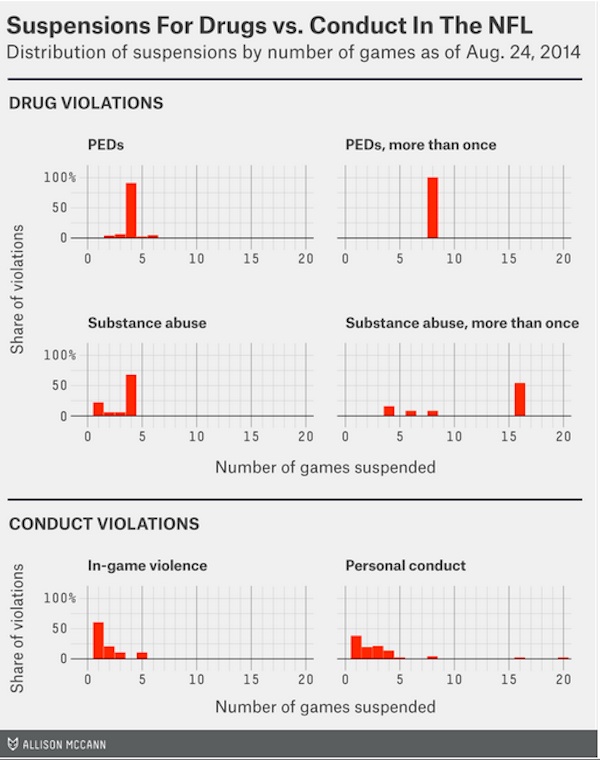
Graph created by Allison McCann
via Five Thirty Eight
Interestingly, when compared to other athletic organizations, particularly in the United States, the NFL is actually ahead of the game. Major League Baseball (MLB) has changed its drug policies three distinct times in the last year, but has no policies with respect to cases of domestic violence. According to the MLB Basic Agreement the Commissioner has the authority to investigate any situation that is “detrimental or materially prejudicial to the best interests of Baseball,” but discipline is left to the discretion of the Commissioner, the Senior Vice President, Standards and On-Field Operations, or a Club, when authority is deferred to it.
Meanwhile, U.S. Soccer, the national governing body for all U.S. soccer teams, has been promoting Hope Solo’s bid to break the all-time shutout record, in spite of recent domestic violence charges the player has received for assaulting her sister and nephew. In fact, the only athletic organization that seems to punish its players for on-and-off field instances of violence with any severity is the National Basketball Association, with 22 players suspended for as little as seven games to as many as 86. Important to note is that the majority of these players were suspended for violent involvement in the 2004 Pacers-Pistons brawl, and only one (Ron Artest, who was coincidentally a key figure in the Pacers-Pistons brawl) was suspended for seven games due to a misdemeanor domestic violence charge.
However, Article VI of the Player Conduct, does discuss ways to discipline and manage violence. The Player Conduct states that “When a player is convicted of (including a plea of guilty, no contest, or noel contender to) a violent felony, he shall immediately be suspended for a minimum of ten games.” Furthermore, if the the NBA and/or Players’ Association suspects that a player has engaged in off-court violence, the player has 72 hours to undergo a clinical evaluation by a neutral party and to attend appropriate counseling if decided by the neutral party. (If the player refuses to go to counseling, he owes the NBA $10,000 for every day after the 72 hours he skips out.)
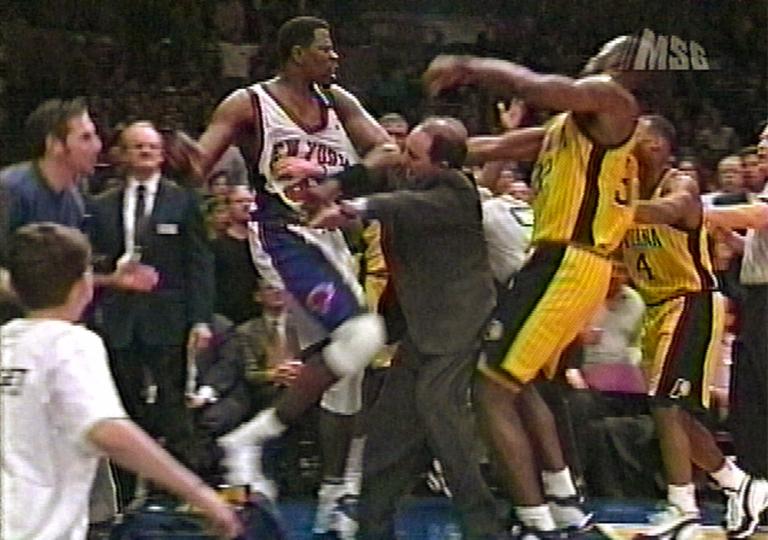
The infamous Pacers-Pistons brawl actually forced the NBA to tighten its policies around on and off-court violence
via SportingNews
In any case, the NFL’s opportunity to test out the Action Plan will come sooner rather than later now that police have arrested San Francisco 49ers’ Ray McDonald on suspicion of domestic abuse. His pregnant fiancée showed cops bruises on her arms and neck, according to the police, though they did not speak about the specifics of McDonald’s arrest. Christopher Mollering, a women’s legal rights expert, guesses that in McDonald’s case, the NFL will take a decisive stance to prove the validity of their recent change. “Given how much flak NFL Commissioner Goodell and the NFL took after suspending Ray Rice only two games, and in light of how recently the league released its new policy — minimum suspension of six games, plus enhancements for incidents involving pregnant women – I would expect a suspension of at least eight games,” Mollering supposed.
Goodell isn’t racing to prove anything to anyone, however. In his most recent statement, Goodell said he “won’t be moving rashly to enforce the league’s newly enhanced personal conduct policy,” and that it’s important to “let the process play out, get the facts, and make sure you understand all the circumstances.” He claimed that “We don’t (know the facts) right now and we’re obviously following it very closely. But the policy will be applied uniformly across players, coaches, executives, commissioners. I think we made that very clear in the policy.”
Roger Goodell’s Action Plan truly may bring the NFL a step beyond the pitiful precedence of disciplining violence in U.S. athletics. However, while the NFL’s Action Plan offers officials a template to handle domestic violence and sexual assault cases, it’s not really a step in the right direction. Step suggests a move forward, whereas the Action Plan is more of a gesture towards accountability. In his piece “So What’s Actually New about The NFL’s New Domestic Violence Policy?”, Barry Petchesky argues, “Now the NFL gets to see its name in headlines touting its zero tolerance policy for domestic violence… But Goodell’s “Message: I care” announcement today isn’t about specifics; it’s about projecting an aura of authority.” The NFL has stumbled over the low bar it has set for itself to appeal to a public that simply wants to see this athletic organization attribute as much gravity to a player’s violent actions as it does to a player failing a second drug test. Also, the clarification that a six-game suspension is subject to adjustment due to “mitigating factors” implies that officials could easily shorten the length of a player’s punishment for any reason. The lifetime ban is also vulnerable to compromise given that a player can petition said punishment after a year. Although Goodell’s letter is long and full of pretty words, this Action Plan is hardly radical, or even very progressive.
Although Goodell’s letter is long and full of pretty words, this Action Plan is hardly radical, or even very progressive. But the Action Plan is not useless, even if it is rather shallow in effect. The NFL is a symbol of patriarchy and many times blatant misogyny, from its obviously sexist Super Bowl commercials to the shameful way that many NFL teams treat their cheerleaders. That the NFL is now saying at least “hey, violence against women is bad,” sends a message to the thousands of people who invest in this institution — a message that, sadly, may not be overly familiar to them. Furthermore, if the NFL is willing to educate the young people who attend their football programs, and to endorse messages that promote the wellbeing of women to some degree, I will take it. It would be foolish and untruthful to act as though the NFL doesn’t hold a lot of socio-cultural authority in the United States; if one of the many problematic bastions of “Americanness” can give publicity to domestic violence and sexual assault prevention, perhaps that threat to misogyny will go some small way towards holding the public accountable.
Ferguson Protestors Get to Meet With US Attorney Callahan, Although Real Progress Still Hasn’t Come
Feature image via Press TV
When Ferguson protestors marched on to the office of U.S. Attorney Richard Callahan on Tuesday, they expected to face police and possibly arrest instead of an hour-long face-to-face meeting. In spite of the summer heat, dozens of demonstrators marched towards the federal courthouse in the first demonstration after Monday, when Michael Brown’s father called for a day of silence in honor of his son’s funeral. After several protestors charged ahead to occupy the steps of the courthouse, against the Department of Homeland Security officers’ forewarning, a St. Louis Metropolitan police officer arranged for a handful of the activists to enter the federal building.
During the conversation the group of Ferguson protestors, which included the leader of a St. Louis community group, the Rev. William Barber, and four other demonstrators, issued their demands with respect to the Michael Brown shooting case. Among the demands of Ferguson protestors, the demonstrators called for the Justice Department to investigate the police’s civil rights violations throughout the St. Louis metro area.
Although the Ferguson protestors’ meeting with Attorney Callahan could be considered a victory of sorts, Callahan did not commit to fulfilling any of the demands. Callahan did promise to raise these charges to U.S. Attorney General Eric Holder. Although the demonstrators have found a moment of success, the Ferguson activists are not letting themselves get too carried away with this recent victory. Chairman of the Local Organization for Black Struggle, Montague Simmons, reiterated the the protestors’ continued commitment to racial justice and anti-police brutality work. Simmons explained, “He heard us once because we stayed in the streets, which means the only way they’re going to continue to take us seriously is for us to stay in the streets.”
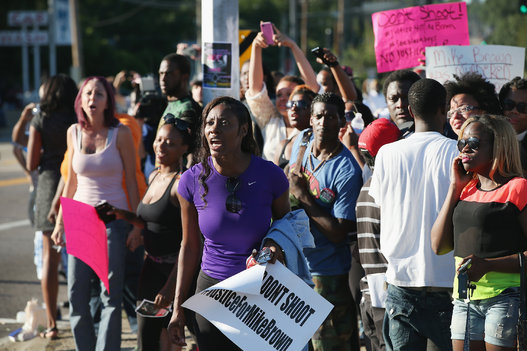
via HuffingtonPost
Not only are demonstrators staying in the streets, but they are also mobilizing elsewhere. The Organization for Black Struggle and ColorOfChange.org are joining forces this Thursday to deliver a petition to the White House calling for a federal investigation of the Ferguson Police Department. In the petition to the Obama administration, activists demand that federal forces examine the way in which police forces across the nation are murdering and brutalizing people of color, particularly men of color. The petition also draws attention to the increased militarization of local police forces. Protestors have called for: trainings to eradicate racial biases within law enforcement; for the Department of Justice to establish investigations conducted by impartial committees in cases where police forces have shot an unarmed civilian; for diversity in the populations of police officers; for quality engagement of police forces with the communities they serve; for a federal commission to examine the policies and behaviors of police departments throughout the United States; and for the appointment of a federal “Czar,” whose job it will be to monitor police forces and to resolve any suspicious behaviors within law enforcement.
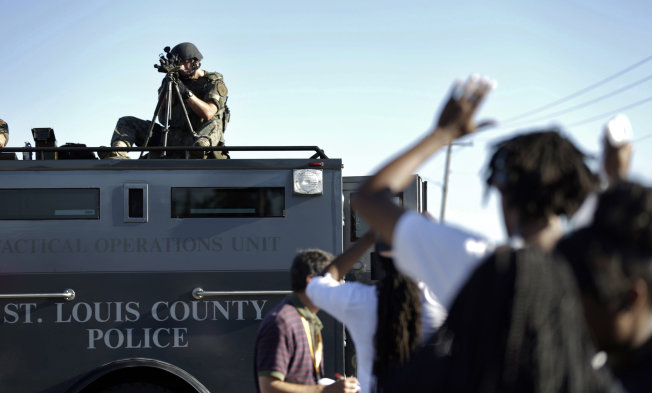
via US News
In this next step, Simmons anticipates that the organizations will meet with an official of the administration, though he did not specify with whom. As these demonstrators have proven over and over again, the best means of effecting change is to continue in action. “What you see is the deepening of a movement,” asserted Rev. Barber. And, this movement will press forward until is sees progress.
Virginity “Tests” for Brazilian Exams Defy Human Rights and Sex Ed
Feature image via Love from Abroad
Within the last year, various states in Brazil have come under attack for discriminatory practices towards female candidates who are taking the public service exams. These public service exams are designed as a selective process to evaluate the capacity for candidates in the roles of government entities and professions; however, a stipulation in many of these exams requires women to undergo invasive gynecological exams to measure the “health” of future public officials.
The highly questionable regulations garnered public attention when activists spoke out against a requirement made by São Paulo’s State Department of Education that female candidates participating in the public service exams, who are virgins, must have a doctor provide a medical testament that affirms their virginity. The State Department’s branch of medical examination (Departamento de Perícias Médicas do Estado or DPME) must also confirm this “proof of virginity.” Those in favor of the requirement suggest that the policy is designed to protect virgins. According to the coordinating body of Human Resources for the State Department of Education, instead of subjecting the candidates to invasive gynecological procedures, the policy would allow virgins to skip the medical examination… if they can prove that they are not sexually active. So, any female candidate applying for a position as a Scholastic Organization Agent, an Administrative Officer, a Public Executive, an Administrative Analyst, a Socio-cultural Analyst, a Technology Analyst, or a Technical Agent for Health Care — all jobs that require that applicants pass the State Department of Education’s public service exams — in São Paulo is assumed to have or have had a vulva with a hymen and must either prove they’ve never had sex or allow medical practitioners to perform invasive procedures on them.
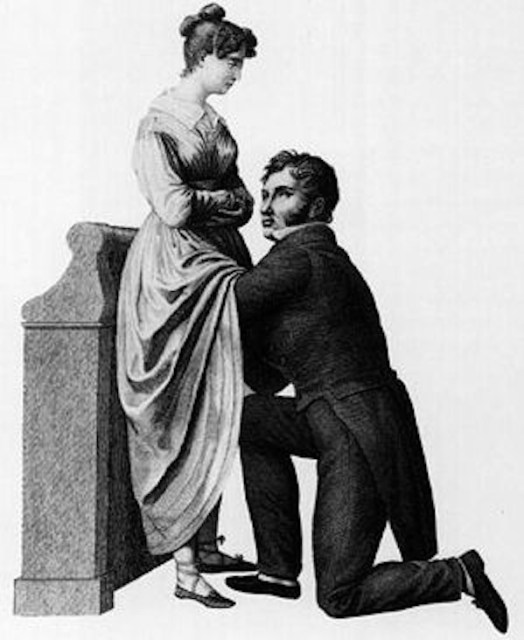
Shoutout to archaic gynecological exams. She looks like she’s having a blast
via JonathanFun.com
São Paulo is not the first state in Brazil to demand gynecological examinations from any female-identified candidates. In 2013, activists also condemned public service exams in the state of Bahia that required any female candidates applying for a position on the Civil Police force to either prove that they are a virgin or to submit to invasive gynecological exams. While the “proof of virginity” stipulation is a relatively new addition, the Secretariat of the Bahian Administration admitted that these policies are a recurring trend in “various public service exams administered throughout the country.” In spite of this trend, many organizations are speaking out against these harmful policies. Catholics for the Right to Decide condemned the policies by asserting that “The submission of executive legislators to religious norms and doctrine for electoral votes is all too familiar for us. The problem is that, beyond violating the constitutional rights of citizens who do not have that religious reference and do not want to have their lives regulated by such norms, this submission directly affects the lives of women and of the LGBT population, in the way that public policies designed for all citizens of the country are implemented or not, as they are approved by these sectors.” [translation mine]
On August 7th, Unified Workers’ Central (Central Única dos Trabalhadores or CUT), Brazil’s main trade union center, released a note in defense of female candidates who face these obscene requirements. In the note, the organization argued:
[translation mine]
“The National Secretariat of Female Workers of Unified Workers’ Central rejects the inclusion of evidence of virginity as a criteria for candidates approved in public service exams as proof of effective characters for jobs as Scholastic Organization Agents, Administrative Officers, Public Executives, Administrative Analysts, Socio-cultural Analysts, Technology Analysts, or Technical Agents for Health Care.
We reject this criteria because we consider it a manifestation of discrimination against women, especially towards those who have not yet engaged in sexual activity, that to occupy these jobs, [female candidates] need to present a declaration from their medical gynecologist to be exempt from exams that cause discomfort.
We reject this action of the State that interferes with the privacy of women and reverts to prejudice and discrimination. It is absurd that in the 21st century, the State causes constraint on and interferes legally with the bodies of women, obligating [women] to submit to exams, [and] above all that these exams do not measure the capacity to function [in the job] for which [the candidates] are selected.
We reject the argument used by the State that these [candidates] need to be without any physical or mental problems. This explanation does not have a real basis, since various illnesses that affect women, when treated, do not make working impractical.
We reject the demand for gynecological exams in selections and public service exams. This practice is abusive. It violates the principle of human dignity, present in the Federal Constitution of 1988.
We reject this practice because it violates the Principle of Equality and the Right to Intimacy, Privacy, Honor, and Image, that prohibits the demand for proof of pregnancy, sterilization, and other discriminatory practices for admission or permanence in juridical relation to work.
We reject this action because it restricts the rights, liberty, and self-determination of women and we urge all to protest against this act of discrimination and prejudice.”
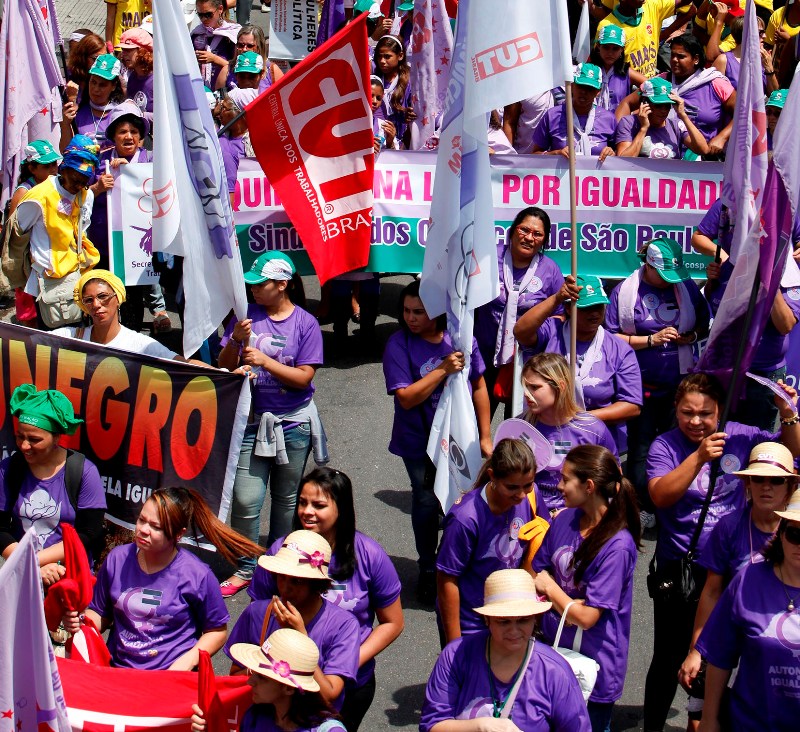
Protest with female workers from CUT
via FETEMS.org
There are more than a handful of reasons why this public service exam policy is fucked up as well as just inaccurate. First of all, the stipulation assumes that every woman has a vulva, let alone a hymen. Virginity tests generally involve an inspection of the hymen and deduce that if the hymen is torn or stretched, the person is no longer a virgin. These tests are foolish because there are a number of reasons why a person’s hymen may be torn, stretched, or not very visible. Tampon usage, physical activity, and natural physical anatomy are all reasons why a virginity test is error-prone. Mostly, these policies are absurd because they are just an extension of regulations on female sexuality.
Although it may be disheartening that even in 2014, state governments are requiring archaic and invasive gynecological exams, these gestures are further proof of the systematic regulating of people with vulvas, particularly those who are female-identified. In these moments, the State denies people their humanity to obtain control over how certain bodies are allowed to operate in space. Furthermore, while this particular instance is specific to Brazil, we see these policies that seek to control people’s behaviors by evaluating a person’s worth and morals by their genitals or sexual activity all over the world, from similar rules in China beginning in 2005 that required gynecological exams for female applicants to civil service jobs, to medical “requirements” in the United States that demand that people with uteri undergo invasive gynecological exams for birth control.
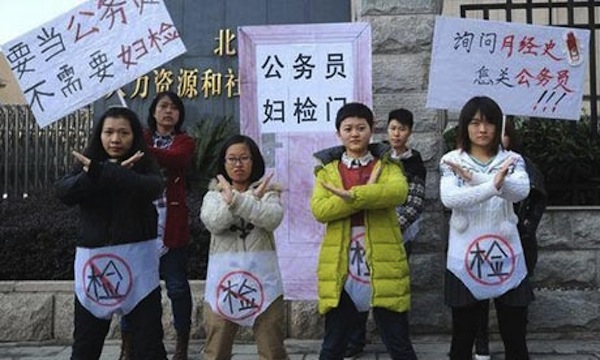
In 2012, Chinese students protested in Wuhan against invasive gynecological exams, required for women applying to work for the civil service
via The Guardian
Fortunately, in the case of Brazil, organizations and groups like Catholics for the Right to Decide, Unified Workers’ Central, the Teachers’ Union of Official Education of the State of São Paulo (Sindicato dos Professores do Ensino Oficial do Estado do São Paulo or APEOESP) and the Commission for the Protection of Women’s Rights have coalesced around the question of human rights for female workers. Perhaps these public denunciations nod to Brazil’s history of feminisms, which have made a significant impact on Brazilian politics. Feminist activism featured prominently in the re-democratization of Brazil, after the fall of the military dictatorship in 1985, leading to a form of feminism that can now be branded as “state feminism.” This state feminism, which is not the only kind of Brazilian feminism or feminist movement, translates the demands of feminist and women’s movements to formulate federal policies. Brazilian “state feminism” negotiates the interesting balance between advocating for a more participatory role for women in political and work spaces, while resisting co-optation from the State.
Although this state feminism does face obstacles, such as ensuring that various feminist perspectives are included in its work and that government forces do not simply use state feminist work as a mere guise for inclusion, it may be key in the overturning of the discriminatory policies surrounding public service jobs. If state feminism in Brazil has acted as a bridge between the needs of civil society and the deeds of the government, it can certainly advocate for gender equality in labor related policies. No government should subject people to invasive procedures that measure their worth because of gender identity, genital anatomy, sexual activity or professional desires.
When We Talk Reproductive Justice, We Need to Talk About Surrogate Parents
Feature image via Solar Navigator
Surrogacy affords many people an alternative way to bring a child into the world. Whether a person is infertile or cannot deliver a baby without medical risk, or a couple is biologically unable to reproduce together without medical intervention — as may be the case for some queer couples — surrogacy enables a person with a uterus to carry a child on behalf of the child’s intended parents. Since 1976, when a surrogate and a married couple made the first modern-day recorded surrogate agreement in the United States, the Organization of Parents Through Surrogacy show an estimated 25,000 surrogate births across the country.
Surrogacy takes different forms. Some pairs use a family or a friend as a surrogate, though a method that is becoming increasingly preferred is the use of a surrogacy agency. Surrogacy agencies act as intermediaries, linking intended parents with a surrogate parent, making arrangements, and collecting fees passed between the two parties. Many people opt to work with a surrogacy agency because the third party can help to simplify legal concerns about parental rights.
However, surrogacy agencies outside of the United States are profiting from poor women and women of color by selling the use of their services to Americans who would rather not pay the high costs of assisted reproductive technology (ART) in their home country or who look to other countries to avoid legal limitations on ART. In countries like Thailand, Ukraine, Mexico, and India, surrogacy agencies are collecting a very pretty penny in reproductive endeavors that circumvent U.S. legal stipulations. For example, estimates suggest that India’s surrogacy agencies have built a $445-million-a-year enterprise. The services benefit these foreigners who, for example, may pay an Indian agency $12,000 versus the $70,000 they would need to pay a U.S. surrogacy agency. In return, the women of color employed as surrogates earn $5,000 to $7,000 for their services, although their U.S. contemporaries earn anywhere between $30,000 to $40,000 depending on their experience. For many surrogates who come from impoverished communities, the $5,000 to $7,000 they can earn for carrying a baby often surpasses even a year’s income from their local jobs, and some do establish wonderful relationships with the baby’s intended parents. Unfortunately, not all agencies and intended parents treat surrogate parents with the care and respect they deserve; moreover, because these operations are not always closely regulated, the surrogates’ rights are left undefended.
Recently, Planet Hospital, a medical tourism company based in California, came under fire for deceiving its U.S. clients, who had hoped to head overseas to hire a surrogate parent. Planet Hospital’s surrogacy services claimed to connect U.S. Americans with surrogates in India, Thailand, and eventually Mexico but essentially would take people’s money and run. The New York Times article focused on the heartbroken couples and agency employees who were outraged at Planet Hospital’s elaborate scam, only mentioning the surrogates’ experience as an afterthought. As horrible as it is that people lost thousands of dollars, human health and wellness has to be a priority. The fact that the agency would disregard the surrogates’ health, like when they authorized the implantation of embryos into an 18-year old woman who had just had uterine cysts removed the day before — and that the surrogates’ struggles are not at the forefront of this debate — suggests that the health particularly of the women of color employed by international ART businesses is not necessarily prioritized.
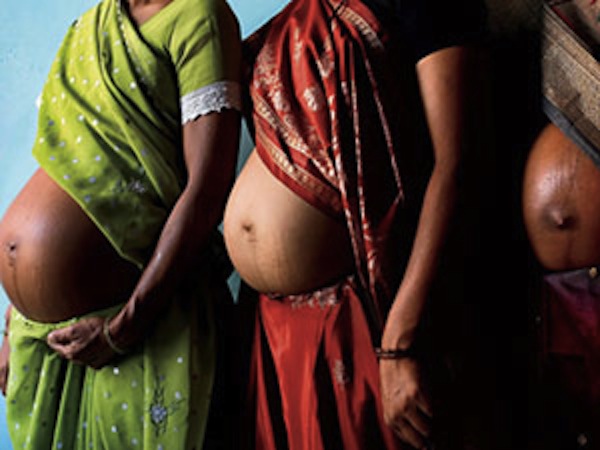
via Marie Claire
In Thailand, a number of problems with surrogacy agencies has led the nation to pursue banning commercial surrogacy. Even though commercial surrogacy is against the Medical Council of Thailand’s code of conduct, regulations cover only doctors and medical institutions, leaving surrogacy agencies to exploit the system. In early August, it came to the Thai authorities’ attention that an Australian couple allegedly had abandoned a child diagnosed with Down’s syndrome that was carried by 21-year old Thai mother Pattaramon Janbua, even though the couple took the child’s healthy twin. To make matters worse, the Australian father is a convicted pedophile and Australian authorities are unable to find the couple and the healthy child. At the heels of this scandal followed accusations that a Japanese businessman has fathered nine children through a surrogate agency but has left them all to the care of nannies in a Bangkok condominium. Thai officials stated that on August 6th that “the draft of a law banning surrogacy has been submitted to the junta’s head of legal and justice affairs and will be forwarded to the newly-established interim legislature for consideration next week.” Rarinthip Sirorat, an executive from Thailand’s Social Development and Human Security Ministry, asserted that a legal ban on commercial surrogacy is designed “to give maximum benefits to the surrogate babies,” an important need, but it is troubling that the government does not seek to protect surrogate mothers like Janbua, whose entire life can be upset by irresponsible intended parents or shady surrogacy agencies.

21-year old mother Pattaramon Janbua holds baby Gammy, who she claims was abandoned by his intended parents.
via Aljazeera
Of course, the aforementioned cases are often extreme scenarios and there are people in countries around the globe who have positive experiences as surrogate parents, as well as people from the U.S. who have negative experiences. However, we cannot underestimate the forces at hand that make international surrogacy potentially dangerous for women of color. Surrogacy in countries with majority Black and Brown people has increased because Western countries have tightened up their laws. Westerners can profit from poor people who do not necessarily have the financial agency to make demands for their rights, and can engage with agencies that exploit legal loopholes. Additionally, the problematic nature of this reproductive exchange reaches national attention more often when white couples and white babies are hurt.
Surrogacy joins the ranks of reproductive technology like birth control testing, forced sterilization, and state-sanctioned policing of abortion that particularly target women of color and poor folks, often for the benefit of white people, and middle to upper class individuals. Reproductive justice is not limited to defending a person’s right to choose to terminate a pregnancy, or to not become pregnant, but also a person’s right to carry a child without fear of discrimination. If these cases are indicative of anything, it’s not that surrogacy is necessarily wrong but that the lack of regulations puts surrogate parents’ rights at risk. Surrogate parents should have the right to transparent surrogate agreements, and the agency to defend their health, financial compensation, and wellbeing. As we fight for reproductive justice, let us also advocate for surrogate safety, so that assisted reproductive technologies are not simply another system that commodifies and exploits Black and Brown people around the world.
Five Things You Should Know about The U.S.’s Criminalization of HIV
Feature image via ThinkProgress
On July 15th, the U.S. Department of Justice Civil Rights Division issued a “Best Practices Guide to Reform HIV-Specific Criminal Laws to Align with Scientifically-Supported Factors” as a measure to encourage state lawmakers to examine laws that target HIV-positive individuals who engage in specific behaviors without first disclosing their HIV-status. The Department of Justice’s guide also advises state lawmakers to eliminate any laws that may prove obsolete. As various states prepare to analyze their criminal laws, here’s a quick breakdown of the relationship between HIV and the law in the United States.
1. The vast majority of states have HIV-specific laws
From the onset of the HIV epidemic in the early 1980s, state governments began developing treatment programs and campaigns to decrease the transmission of the sexually transmitted virus. However, in their efforts to control the epidemic, state governments also began instituting laws that would punish individuals who transmitted HIV to another person. In 1986, Florida, Tennessee, and Washington were the first states to implement HIV-specific criminal laws. Four years later, in 1990, the Ryan White Comprehensive AIDS Resources Emergency (CARE) Act, which funds states for AIDS treatment and care, required every state to certify that its criminals laws adequately could prosecute any individual with HIV who knowingly exposed another person to the virus. By 2011, 67 HIV-specific laws had been enacted and 33 states had one or more of those laws.
Out of the 33 states with HIV-specific laws, 24 states require that HIV-positive people reveal their status to their sexual partners and 14 of those 24 states require that HIV-positive people reveal their status to any needle sharing partners. Furthermore, 13 of the 33 states with HIV-specific laws criminalize prostitution or solicitation, while 11 states criminalize low-risk behaviors, such as oral sex, or negligible risk behaviors like biting, spitting, throwing bodily fluids, or mutual masturbation. In 18 of those 33 states, if an HIV-positive individual is convicted of these behaviors, they can receive a maximum sentence of up to ten years, while five states offer a maximum sentence of greater than 20 years.
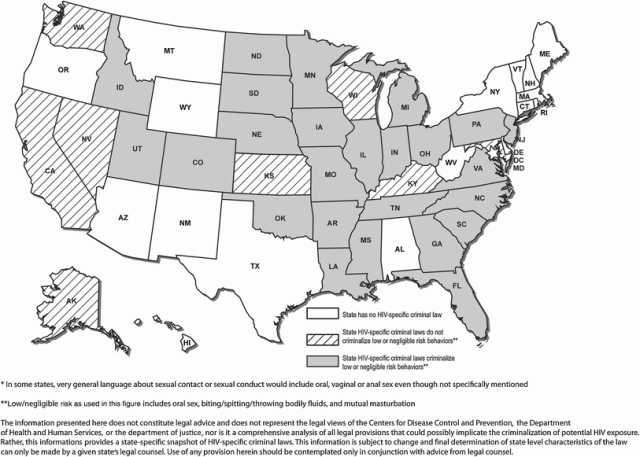
A map of the states with HIV-specific laws
via ThinkProgress
2. Many HIV-specific laws are outdated
Remember how I said that some negligible behaviors like biting, spitting, throwing bodily fluids, or mutual masturbation can be terms for prosecution under HIV-specific laws? Well, we know in 2014 that spitting on someone won’t transmit HIV, but when healthcare professionals first began diagnosing people with HIV, even officials had limited knowledge about how the virus spread. Given that we know a lot more about HIV and even AIDS in the 21st century, it does not make sense that these HIV-specific laws don’t even incorporate modern information. Also, in spite of the fact that there are more options for and that more people have access to safer sex methods, condoms and other items for sexual protection are rarely viable as a defense during prosecution. These laws also don’t take into consideration HIV prevention measures that decrease the chances for transmission like antiretroviral therapy (ART), or pre-exposure prophylaxis (PrEP). Even the federal government is suggesting now that it is completely unhelpful to base HIV-specific laws on outdated information. Acting Assistant Attorney General Jocelyn Samuels for the Civil Rights Division admitted, when discussing the Department of Justice’s new guide, “While initially well intentioned, these laws often run counter to current scientific evidence about routes of HIV transmission, and may run counter to our best public health practices for prevention and treatment of HIV.”
3. HIV-specific laws target marginalized people and increase their marginalization
According to the Center for HIV Law and Policy’s Positive Justice Project, “HIV exposure laws are applied unfairly and selectively, targeting those who are socially and economically marginalized, such as sex workers, while those with other STIs or infectious diseases are not targeted.” Poor people, LGBQ people, people of color, and especially trans people living with HIV, who already generally face increased discrimination under the law, are prosecuted more frequently. Moreover, the harsh sentences that don’t reflect the level of harm that the individuals may or may not have caused add to the victimization of these marginalized groups. Not to mention that upon release from prison, people with HIV who were incarcerated for not disclosing their status must register as a sex offender. Thus, these individuals not only face discrimination for having an illness, but they also face housing, employment, and additional social marginalization for being a registered sex offender. Without a doubt, the criminalization of HIV in the U.S. does more to encourage the stigmatization and hatred of people with HIV than to prevent people from transmitting the virus to others.
4. Criminalizing HIV does not decrease risky behavior
The way that the criminalization of HIV in the U.S. works is that if you knowingly have HIV and still engage in “risky” behavior — which can vary from vaginal or anal sex, to sharing needles, to getting your saliva on someone else — but do not tell anyone else who is participating in these behaviors that you are HIV positive, you can be prosecuted. The easiest way to avoid prosecution, given that it isn’t guaranteed that you can prove that you disclosed your status even if you did inform any partner(s) that you have HIV, is to not know whether you are HIV positive or not. The criminalization of HIV actually encourages people to avoid getting tested for the virus because they will not be held accountable by the law for transmitting the virus if they did not know they have HIV. HIV-specific laws also encourage people to not get treated because many healthcare providers are obligated to share medical records related to a person’s HIV status in the case of investigation or trial. Some healthcare providers require their patients to sign documents that hold the patients liable for criminal conduct should they engage in “risky” behaviors. These laws that allegedly exist to make the world safer actually promote mistrust between patients and healthcare providers, and essentially force people to live sick and untreated for fear of prosecution.
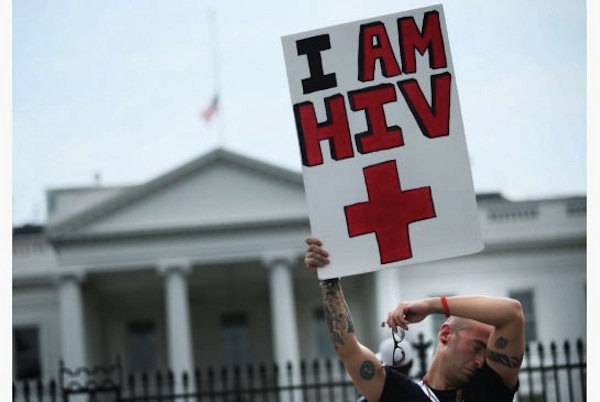
via The Star
5. Only one state so far has repealed its HIV-specific criminal statute
In late May, Governor Terry Branstad of Iowa signed a law to repeal the state’s HIV-specific criminal statute; however, the repeal does not mean that there are no longer any laws that prosecute people with HIV. Instead, the Governor’s decision enacted a tiered sentencing system that considers whether the individual in question intentionally transmitted the virus, whether there was a significant risk of transmission, and whether transmission occurred at all. Fortunately, the new law ensures that prosecuted people with HIV no longer need to register as sex offenders and those previously forced to register as sex offenders retroactively will lose the sex offender registration. The law also incorporates other infectious diseases into its parameters which stops the law from being HIV-specific, but also allows for the criminalization of other illnesses. Considering that only one state has repealed its statute and even in its repeal, the law still proves problematic, it will take a great deal of time before we see some effective decriminalization.
The criminalization of HIV in the U.S. is just a mechanism to regulate the behavior of people living with HIV. It encourages riskier behavior than it aims to prevent by shaming and forcing people to avoid testing and treatment. It also furthers incorrect information and assumptions about HIV transmission by preserving HIV-specific laws that do not consider modern advances in medical technology. Most importantly, the criminalization of HIV promotes unhealthy standards for sexual relationships by victim blaming those with HIV instead of teaching people to have sex with both their partner’s and their own safety in mind. Sex and needle sharing can happen between multiple people and these laws don’t encourage mutual responsibility. Instead of placing the burden solely on those diagnosed with HIV, the burden should also be on anyone else engaged in sexual activity or any other behaviors that put a person at risk for contracting HIV. HIV-specific laws cultivate a culture of shame and stigmatization around disease and it’s about time to break this chain of social violence.
Azealia Banks Released from Interscope in Long Battle to Defend Her “Black Girl Craft”
Badass bisexual rapper Azealia Banks is finally getting out of her record deal with Interscope, as reported by the artist on July 10th. Banks took to twitter last Thursday and announced (in all CAPS), “IM ABOUT TO GET OUT OF MY DEAL!!!!!!!!!!!!!!!!!!!!! THATS THE BIG SURPRISE!!!!! (sic).”
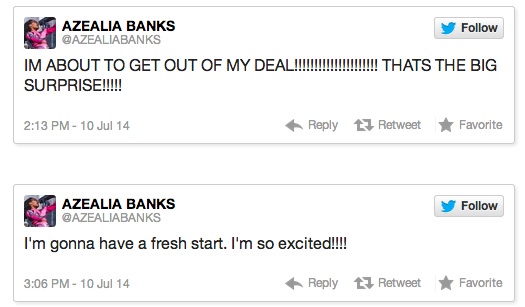
via Twitter
From January of 2014, Azealia Banks has voiced her frustration with Universal, Interscope Records’ parent company. The social media-savvy musician wrote on Twitter, “Universal just needs to hand me over to another label that knows what to do with me. I’m literally begging to be dropped from Universal.” The biggest source of tension, it seems, between Banks and her record label stems from Universal’s decision to repeatedly delay the release of Banks’ debut album, Broke With Expensive Taste. The album initially was scheduled to drop in September of 2012 — almost two years ago — was rescheduled for February of 2013, and now reportedly is set to be available for purchase in the summer of 2014, but with no specific release date. As Banks’ explained on twitter, she was “riding off of mixtape fumes for the past two years,” and her record company’s decision to postpone her official debut is jeopardizing the rapper’s art and also, if we’re being honest, probably her finances.
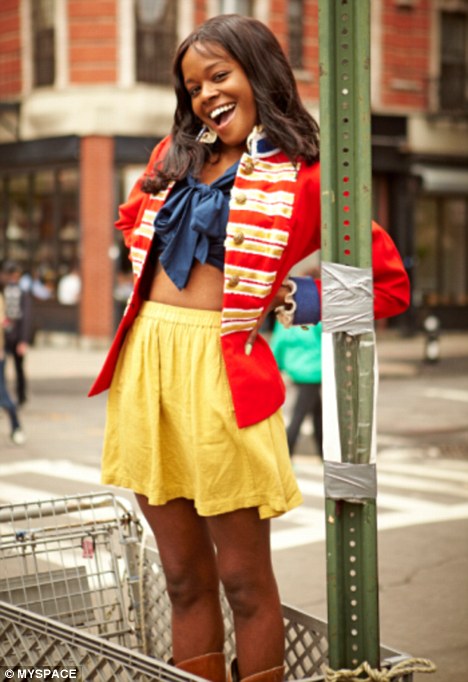
via DailyMail
Aside from Banks’ marketing problems, the “Fuck Up the Fun” artist also asserted via social media that she’s sick of “having to consult a group of old white guys” who don’t particularly understand her “Black girl craft.” For a performer that proudly stated, “I don’t live on other people’s terms,” when she first came out as bisexual, her tendency to play by her own rules stands in direct conflict with the way record companies like their contracted artists to behave. Also, Banks’ musical breakup with Universal is not the rapper’s first; in 2011, Banks left XL Recordings because she felt that the company did not take her seriously and did not respect her artistic choice. After terminating her relationship with XL recordings, Banks went back to her roots, using social media to release tracks just like she did in 2008 when she first took to MySpace to offer her music to the world. By the next year, she had attracted the attention of record labels and business people, eventually signing on with Interscope.
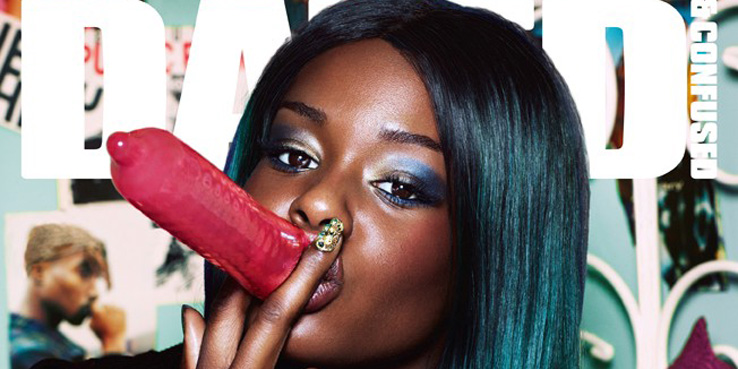
via 24HourHipHop
Although in her January twitter complaint, Azealia Banks pleaded for someone at Sony Records to buy her from Universal, perhaps Banks is beyond contracts and record deals. Azealia Banks is creating something new with a sound that defies the boundaries of mainstream hip hop and destabilizes the tradition of house and electronic music embedded in her work. While some may consider her refusal to compromise impulsive and unwise, Banks is committed to defending the magic of her art. In this way, Banks may be ushering us into an era where musical artists are pushing back even harder against the industry in an attempt to negotiate success and their craft. Banks’ long battle with Interscope is coming to an end, but her long battle with those who will try to sanitize the rapper’s work until it is as “marketable” as possible is not. Hopefully, Banks’ fight will yield a long-awaited debut album.
Web Series “Twenties” and Lena Waithe, its Queer Black Writer, Are Headed For BET
Feature image via News One
Remember that time we told y’all to check out this cool web series called Twenties because it was developed by a queer Black woman and told the story of a twentysomething-year old queer Black woman and her friends?! Remember!? Well… Twenties will be making its way to BET now that the series’ writer, Lena Waithe, who is also a queer Black woman, has signed a deal to write a pilot script!
Last summer, Waithe invited the technologically-inclined to watch and share episodes of “Twenties” that she posted on YouTube to show that a series about young women of color really could garner an audience. The comedian-writer, who also produced Dear White People, had brought the show’s idea to various networks but was met with resistance from producers who thought that the concept would not bring in a strong viewership. Well, Waithe’s call to action proved the naysayers wrong and Flavor Unit, the Queen Latifah-owned production company that produced Twenties’ webisodes, will offer its support again and produce the show for BET.
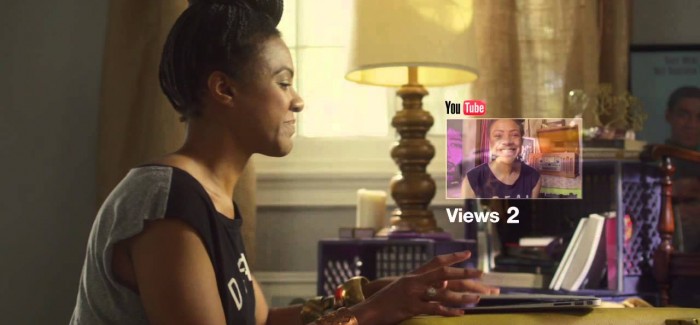
via ElixHer
Speaking about how she wants people to experience the show, Waithe suggested that active audience engagement is one her main objectives. “We want to be entertaining, but we also want to make people think and not just sit back mindlessly,” Waithe explained to Variety. She added, “We really want them to sit up and pay attention.”
Furthermore, it is very important to Waithe that stories about marginalized groups like women, Black people, and queer people can be depicted in comedy beyond demeaning stereotypes. From the webisodes, it’s clear that Twenties aims to humanize people who often don’t get to hear their stories told. Waithe sees this project as a show with lasting impact. “My goal is to shoot the most amazing pilot possible, but for people to not just love it today but for them also to watch it 20 years from now.”
So congratulations to Lena Waithe for proving that we want to see different stories on our televisions (or computers for those of us without cable). And congratulations to you out there whose numerous views gave this series the support it needed. While you wait for the BET pilot episode of Twenties, watch some of the webisodes again!
FIFA Claims “Zero Tolerance” On Discrimination; Citizens of World Cup Host Countries Might Disagree
Feature image via Funcheap
On Thursday, June 19th, FIFA announced that it was opening a case against Mexico to investigate the “improper conduct of spectators” a week earlier on June 13th, and on June 17th. The disciplinary proceedings began after allegations that Mexican spectators had used homophobic slurs during Mexico’s World Cup match against Cameroon and then later during the second match against Brazil. The organization also sought to punish Brazil for its fans’ use of homophobic slurs in retaliation against Mexican fans. However, only five days after FIFA announced the investigation, the organization has decided to drop all charges.
FIFA’s disciplinary panel explained that the chant issued by Mexican spectators “is not considered insulting in this specific context” and thus the investigation can be dropped. Indeed, there is a lot of disagreement about linguistic and cultural connotations of the word “puto,” which some Mexican soccer fans yell when an opposing team’s goalkeeper takes a kick. Hector Gonzalez Inarritu, chief operating officer of the Mexican national team, defended the chant as a cultural tradition, clarifying, “It is not aggression — it is something that we’ve had for a long time in the Mexican League and in international matches.” Others, like Piara Powar, a member of FARE (Football Against Racism in Europe) and the Committee Against Racism, condemned the homophobic gesture claiming that “FIFA has strong regulations in this regard. Zero tolerance is what is required here.”

via Capolista
When FIFA initially committed to taking action against Mexico and Brazil, officials asserted in a statement that “FIFA takes a firm, zero-tolerance stand against any form of discrimination or racism.” Furthermore, Brazilian President Dilma Rousseff and FIFA President Sepp Blatter publicly announced their intentions to use the World Cup as a “platform to fight racism and discrimination.” Contrary to what President Rousseff and Blatter may daydream about, the World Cup has been a site of discrimination for a while.
On a smaller scale, there have been a series of neo-Nazi gestures at World Cup matches. Although Mexico and Brazil have taken a lot of heat for homophobic chants, FIFA officials spoke out against Russian and Croatian fans who displayed neo-Nazi banners during their matches against South Korea and Brazil, respectively. Also, at the Ghana-Germany game on June 21st, a Nazi sympathizer rushed the field, removing his shirt to reveal a Nazi message scrawled in black against his chest. Other spectators donned blackface for the game. Article 3 of FIFA’s Statutes implies that legal action will be taken against discriminatory groups or individuals. The article defines forms of discrimination as:
“on account of race, skin color, ethnic, national or social origin, gender, language, religion, political opinion or any other opinion, wealth, birth or any other status, sexual orientation or any other reason.”
Nevertheless, FIFA has not made clear what actions — if any — it will take against Russia and Croatia.
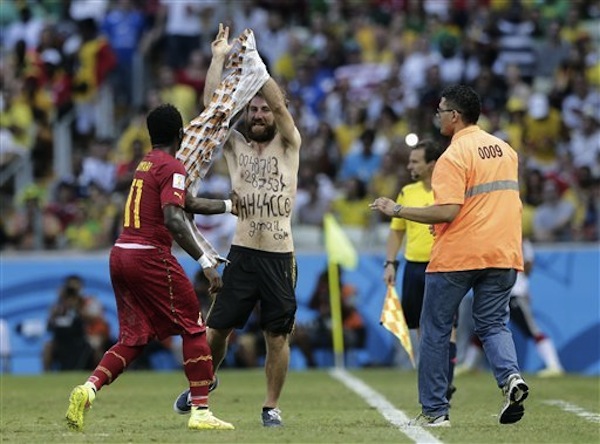
The neo-Nazi infiltrator takes off his shirt to reveal the message on his chest at the Ghana-Germany game
via News Observer
While FIFA cannot be blamed for individual groups that bring their hatred across borders, the World Cup in and of itself is a symbol of discrimination. Brazilian protestors have brought attention to the government corruption, police brutality that has resulted in the loss of civilian lives, and the gentrification that has led to the displacement of poor and Black Brazilians, all in the name of promoting the World Cup. Brazil is not an isolated example of the discrimination and societal violences that take place to make the World Cup possible; because of the 2010 World Cup in South Africa, legislation like the “KwaZulu-Natal Elimination and Prevention of the Re-emergence of Slums Act” arose as a measure to “clean up” the KwaZulu-Natal province in time for the soccer tournament, but actually surfaced as a tactic that further marginalized imojondolo, or “shackdweller” communities and invoked apartheid policies.
National governments enter into an agreement with FIFA to make accommodations for the capitalist spectacle of the World Cup by any means necessary. FIFA endorses a false “zero tolerance” for discrimination, though the money that funds the organization is often tied to the marginalization of already-oppressed groups. Furthermore, its show of international, friendly competition is a masquerade that hides the prevalent power dynamics that govern how citizens of various nations relate to each other on a global level. Especially with respect to non-Western host countries, the World Cup turns these nations into tourist traps and business ventures where the only way the Western world is encouraged to relate to these countries is through a process of exotification and commodification.

via Copa 2014
The World Cup fans who have chosen to support their nations through homophobic and/or racist chants need to do better, and FIFA should be encouraged to continue its public condemnations of the oppressive behaviors demonstrated by the spectators. However, FIFA’s commitment to anti-discrimination work is a shallow pledge that only exists insomuch as FIFA can act as the judge to outside groups and individuals that threaten the image of the tournament. Where are FIFA’s anti-discrimination statutes when the governments who host the World Cup oppress the poor, and the Black and Brown people? FIFA’s so-called platform to fight discrimination and racism is rather short and shaky.
South Carolina Punishes Universities for LGBT Reading List with Extra Dose of America
Feature image via Think Progress
As a punishment for spending university resources on LGBT-themed reading material, two state-funded South Carolina schools are being required to teach about the United States founding documents. The University of South Carolina Upstate had the audacity to include Alison Bechdel’s graphic memoir Fun Home: A Family Tragicomic on its optional freshman reading list, while the College of Charleston irreverently incorporated Out Loud: The Best of Rainbow Radio, written by gay poet Ed Madden, into its summer reading assignments for its English 101 course. The nerve of these schools.
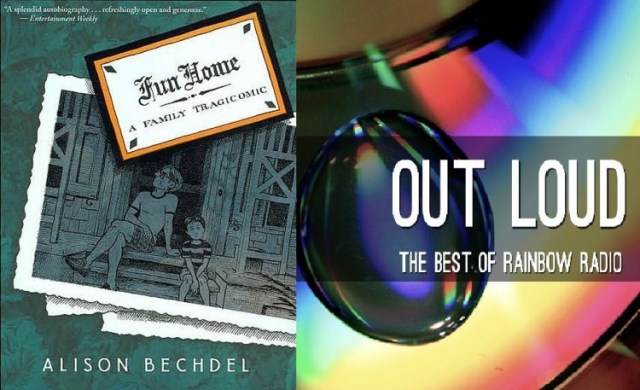
via GLAAD
The South Carolina State House was so outraged about the LGBT-inclusive reading material that it planned in March to cut $52,000 from the College of Charleston budget and $17,000 from the USC Upstate budget, with each respective budget cut reflecting the amount of money that the universities spent on queer literature. The South Carolina Senate, on the other hand, had a better idea; the Senate voted to restore as much money as the universities spent on LGBT-themed reading material back to the schools with the stipulation that the schools devote the reinstated funds to courses that teach about the U.S. Constitution and other founding documents.
“We spoke to the fact, ‘You did something wrong,'” said Sen. Larry Grooms, the politician who added the requirement about how the universities must spend their new funds to the budget amendment. “This is a way of making amends.”
The budget amendment also allows students to receive an alternate required-reading and allows students to skip a mandatory lecture or seminar (as long as it’s not part of a class) “based on sincerely held religious, moral, or cultural belief.” The budget amendment also makes reference to an outdated state law that “requires colleges to teach the founding documents for a year and graduates to prove loyalty to the United States before receiving a degree.” So if you can justify your prejudice and bigotry by a particular belief system and are convincingly loyal to the United States government, you can read whatever you want. You’re on your own though if you like reading “pornography” — which is how Sen. Grooms described LGBT-inclusive literature.

This is Larry Grooms. Boo Larry Grooms
via Advocate
Although South Carolina governor Nikki Haley has approved the budget amendment, not all South Carolina politicians support the regulations. Democrat Sen. Brad Hutto criticized the Senate’s decision, exclaiming, “You can wish away homosexuality all you want. It’s been around for eons. …It’s time for us to move into the century we live in.” The incoming, Republican president of the College of Charleston, Lt. Gov. Glenn McConnell, reflected that the amendment “chills academic freedom. Just because you disagree with people is not a reason to penalize them.”
LGBT advocates in South Carolina aren’t pushing back too hard, with executive director of LGBT rights group SC Equality Ryan Wilson suggesting “We all could learn something here.” It’s true that the State of South Carolina is providing us with a teachable moment. What I find most interesting about the South Carolina Senate’s decision is that somehow homosexuality and queerness are being constructed as mutually exclusive to “Americanness” or some kind of commitment to U.S. nationalism. Politicians like Sen. Grooms are insisting with this move that the remedy to these universities allocation of their funds to LGBT-inclusive literature — and mind you, the schools by no means banned “heterosexual literature” or mandated that all courses had to incorporate queer related texts — is to promote academic disciplines that support a more U.S.-centric approach. This gesture evokes outdated ideologies that portray queerness as anti-U.S. American, anti-patriotic, and a threat to U.S. principles. While I don’t think USC Upstate and The College of Charleston intended to complicate our understanding of queerness, perhaps Grooms has a point. Queerness, in its most politicized form, is a threat to the bigotry, hegemony, white supremacy, genocide, and misogyny present in the U.S. founding documents. A commitment to queerness reminds us of the institutional violence that the United States has enacted in a number of ways against its citizens, residents, and on a global level. If you need to straighten out (pun intended) these universities by bringing students back to the beginning of U.S. oppression, you indeed are teaching a lesson about the roots of injustice that perhaps speaks for itself. For the student who lost the option to read Fun Home and now sees increased support for U.S. history courses and literature, the South Carolina Senate has provided a curious demonstration of “progress.”
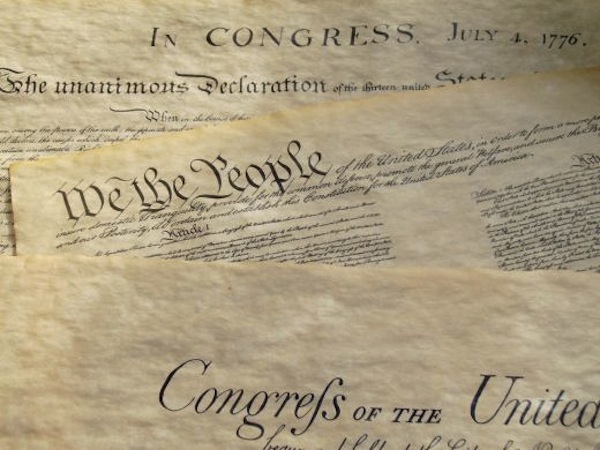
Who wants to read “pornography” when you can read the Constitution, am I right?
via Citizens Project
Although the South Carolina Senate has offered a meta educational opportunity with its budget amendment, the news is still incredibly heartbreaking. Furthermore, along with the budget amendment, USC Upstate is closing its Center for Women’s and Gender Studies in a budgetary move to save the University $45,000 a year. Chancellor Tom Moore assures that the closing was not related to the Center’s LGBT symposium. It is important to mention, however, that a performance of the play How to Become A Lesbian in Ten Days or Less during the LGBT symposium was cancelled after South Carolina legislator, Mike Fair, denounced the play as an attempt to recruit young women to be lesbians even after graduation. These budget moves, which take effect July 1, 2014, demonstrate that the struggle for LGBT rights has come to the academic realm, but that instead of fighting with knowledge and intellectualism, these battles unfortunately are fought with state monetary resources.
Lesbian Rapper Siya Comes to Your TV on Reality Show about Women Rappers
Brooklyn emcee Siya joins the ranks of upcoming women rappers featured on the reality show Sisterhood of Hip Hop. Grammy award-winning rapper T.I. is the executive producer of the program which will follow Bia, Brianna Perry, Diamond (of Crime Mob), Nyemiah Supreme and Siya as the women strive to create successful solo careers. Sisterhood of Hip Hop will issue a teaser episode on July 22nd and air its serial debut on August 12th.
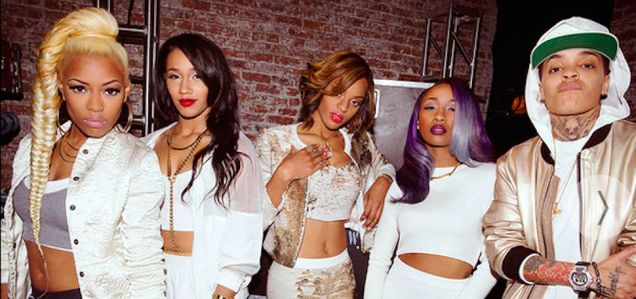
via Jezebel
Siya’s presence in the show definitely offers a welcome perspective into the diverse lives of artistic queer women. In an interview with Fuse TV, Siya discusses some of the hardships she faced in her early life, saying “My mother was on drugs and my father was incarcerated for the rest of his life. All the struggles that I went through made me exactly who I am. So I’m not ashamed of anything I went through.” Truly it’s encouraging to see a lesbian performer openly discuss her background without shame.
Furthermore, by appearing on Sisterhood of Hip Hop, Siya grants visibility to more masculine-presenting queer women of color whom mainstream media often fails to represent. She uses her musical platform to raise awareness about issues that queer people and especially queer people of color may face. In the 2012 single “D.Y.K.E. (Damn You Killin’ Em)” from the mixtape of the same name, Siya talks about her coming out process in the first thirty seconds of the song, confessing, “I used to struggle ’til I found the courage to say fuck it, that’s what it is/Coming out was never easy, but neither was denying it/My grandma said she loved me no matter who I was lying with.” She goes on to talk about negotiating religion and homosexuality and also reveals that as a female rapper, she’s expected to embrace a stereotypical form of femininity (“But to be honest I’m not polished like these bitches with deals/Probably’ll never be acknowledged until I put on some heels”).
Sisterhood of Hip Hop is an important move in promoting women’s contributions to hip hop. In spite of women like MC Lyte, Foxy Brown, and Queen Latifah, who have disrupted the way that hip hop has centered predominantly on male artists, women still have to fight to be taken seriously in the rap industry and face sexist double standards in terms of how their success is measured. Sisterhood of Hip Hop proves that women don’t need to earn a space in hip hop because we already belong there. Keep your eyes out for the series, airing on Oxygen later this summer, and pay special mind to Siya!
The Danger at the Intersection of Street Harassment and Compulsory Heterosexuality
The first time I learned about street harassment, I was taught that only I could prevent it. This was about the same time that Smokey the Bear was telling me that only I could prevent forest fires and Captain Planet told me that the power was mine to save the Earth. The world was sure entrusting a lot to seven-year-old me.
The aforementioned logic about street harassment taught me that street harassers targeted only “sluts and whores.” This overwhelmingly male population that felt the need to humiliate women were never referred to harassers, assailants, or even bullies, but instead regarded as some sort of moral authority that reminded women when they were demeaning themselves. My job was simple: if I had the self-respect or dressed properly and carried myself with dignity, my friendly neighborhood Hemline Police and Cleavage Monitors would not have to encourage me to cover myself up with their lewd comments and unwarranted advances.
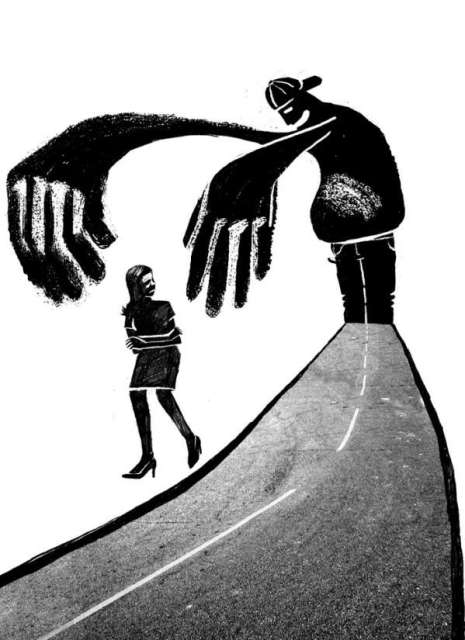
Sergeant Street Harasser says only you can prevent female objectification. Right…
via Ms Magazine
My first incident with street harassment took place during a visit to the ultra-conservative Jamaican town my parents grew up in. I had entered the tumultuous, hormone-fueled pubescent era of my life, and my baby fat had begun migrating towards my hips and ass. On the day in question, I walked to a small corner shop with my cousins, and following the town’s standards of propriety, I was wearing a bright blue skirt that flowed almost to my ankles. I did not understand that I was being catcalled until my cousins pointed out the male attention. I was bewildered in part because I didn’t know why these men would want me to be interested in them, but mostly because I was following the “rules” by wearing a long skirt! One of my cousins explained to me that the color of my skirt made my butt fluorescent and implied that I should not wear such colorful clothing around my derriere if I don’t want to be hit on. Admittedly, there was a part of me that appreciated that puberty had my body interesting — plus, I hadn’t discovered that I was super gay yet — but I felt really ashamed of my failure to be modest. I went home and never wore that skirt again.
Ten years and countless obnoxious, absurd, often racist catcalls later, I fortunately have learned that street harassers are not trying to encourage me to dress with decorum, nor is it my fault if someone antagonizes me that way. Mostly, what I’ve learned is that I’m unfortunately not alone in this phenomenon. This year, Stop Street Harassment (SSH) commissioned a report wherein they found that out of the 2000 U.S. Americans studied, 65% of women surveyed had experienced street harassment. 23% of these women also said they hey had been touched sexually in these incidences of street harassment, twenty percent had been followed, and for 9% of participants, the harassers forced the women to do something sexual.
Interestingly, the SSH also studied LGBT-identified individuals. The SSH research has made me think about what it means for us queer women to be harassed on the streets. Although the SSH report suggests that there is not a significant statistical difference in what percentage of LGBT-identified women are harassed versus their heterosexual counterparts, I do think that street harassment impacts queer women differently. Street harassment is vile and unpardonable no matter the sexual orientation of the perpetrator or the target, and being attracted to men as a gender in no way means that one is inviting or justifying harassment. However, for LGBTQ-identified women, street harassment often demonstrates the additional violence of compulsory heterosexuality and heteronormativity.
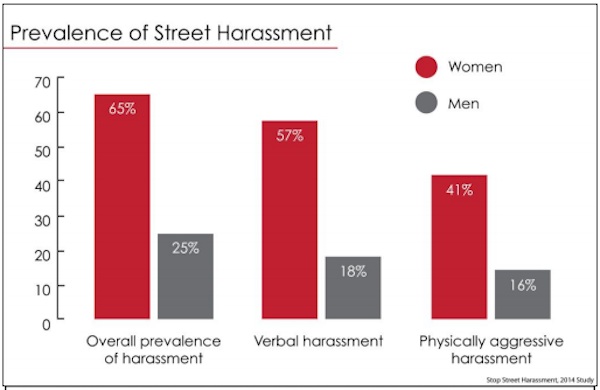
via Feministing
What happens at this juncture of street harassment and compulsory heterosexuality? A higher percentage of LGBT-identified women in the survey reported experiencing daily harassment (7% of LGBT-identified women versus 1% of straight women), and I’m curious to know if researchers asked their subjects what happens in those moments of street harassment. The report does not detail the delegitimization of and attacks on our sexual orientations that these street harassers will use to suggest that we truly should be interested in them; the ways in which LGB women can be targeted not only on the basis of their disinterest in one particular man, but disinterest in men generally. When we have these conversations about street harassment, we don’t always talk about the unique experiences LGBQ women face because of the men who want to “fix” us. We don’t always talk about the men who take our queerness personally and the “corrective rapes” that sometimes follow these public assaults on our sexuality. In my own experience, I’ve noticed that many of the monsters that lurk on our streets specifically target women who do not conform to hegemonic standards of femininity. Furthermore, the attacks increase disproportionately when race is factored into the equation. 41% of Black and Latina women versus 24% of white women experience street harassment regularly, as noted in the SSH report. For queer Black and Latina women, racism and homophobia can triple the axes of violence.
Trans women by far face increased persecution in public spaces, and are harassed by both men and women both because of their womanhood and their trans status. Given the murders of Islan Nettles, Ashley Sinclair, Kelly Young, Cece Dove, Amari Hill and countless others murdered as recently as 2013, it’s important to remember that the harassment of trans women and especially trans women of color isn’t just a microaggression; it can easily become deadly. Certainly, cis and straight women suffer from street harassment, but the degrees of violence and victimization multiply with every added marginalized identity.
In LGBTQ spaces, we do talk about the verbal and physical attacks queer people face and the disproportionate number of trans murders. However, I want these issues to feature at the center of mainstream conversations about street harassment. We need to put street harassment into perspective, especially for LGBTQ women. Street harassment is not a concerned suggestion for us to dress more modestly, nor is it a mere inconvenience. When street harassment functions as a way to enforce compulsory heterosexuality, it’s violence and it can be murder. Harassment is an epidemic for all women, but for those of us additionally marginalized because of sexual orientation, race, gender, and/or gender presentation, we have even more to fear. The streets are what connect us to our communities and community members. They should not be sites of oppression and until we honestly confront the dangers different individuals face on their streets, we cannot figure out how to make these spaces safe and end street harassment.
Rest in Power, Yuri Kochiyama
On the evening of Sunday, June 1, 2014, the world lost a revolutionary, civil rights activist Yuri Kochiyama. Kochiyama died in her sleep at the age of 93 due to natural causes, according to her family. The Japanese-American figure featured prominently in the political uprisings and movements of the 1960s, fighting for racial justice and equality. Diane C. Fujino, who wrote Kochiyama’s biography Yuri Kochiyama, Heartbeat of Struggle, describes the late activist’s significance by stating, “Most people make life; some people make history. Yuri organized her life around making history. I think of her as a very ordinary person, who’s done extraordinary things.” Let’s celebrate the brilliant way Kochiyama made both life and history.
Kochiyama was born Mary Yuriko Nakahara to Japanese immigrant parents in San Pedro, California. She spent most of her early life growing up in a predominantly white community until the Pearl Harbor bombing in 1941. The United States government began forcefully relocating anyone of Japanese ancestry — whether citizens or immigrants — to internment camps the following year and Kochiyama spent two years at the Jerome Relocation Center in Arkansas. This period of internment and the U.S. government’s human rights violations would inspire Kochiyama’s later activism.

via Tavern Keepers
Kochiyama met her husband, Bill Kochiyama while in the internment camp and the two married after World War II. The two moved to New York City to start a family, and when a larger apartment became available in Manhattanville housing projects, the couple moved themselves and their six children to Harlem. This move brought the Kochiyama’s right into the hotbed of U.S. racial politics and an emerging Black nationalist movement.
Before long, Kochiyama entered the political scene, facilitating and supporting a variety of different political movements. Using her organizing skills, Kochiyama maintained a network for political prisoners once the FBI began arresting civil rights leaders and activists. Kochiyama acted as a point person both for people detained and for those released. Activist Mutulu Shakur reflected that “Anybody getting arrested, no matter black, Puerto Rican, or whatever, our first call was to her number. Her network was like no other.”

via BlackPast.org
Indeed, Kochiyama embodied a spirit of intersectional politics, advocating on behalf of various marginalized and disenfranchised groups. Kochiyama engaged in Black nationalist politics, becoming good friends with leaders like Malcolm X; moreover, when Malcolm X was assassinated at the Audubon Ballroom in 1965, Kochiyama was the first person to run to the slain activist and cradled his head in her lap. Kochiyama supported the struggle for Puerto Rican independence and the release of political prisoners in 1977 by joining a group of Puerto Rican activists who took over the Statue of Liberty and hung the Puerto Rican flag across “Lady Liberty’s” forehead. And, in the 1980s, Kochiyama and her husband fought for government reparations and an official apology for the U.S’ horrific decision to intern people of Japanese decent in the 1940s. Former president Ronald Reagan enacted this apology to former internees by signing into law the Civil Liberties Act in 1988.
After a debilitating stroke in 1997, Kochiyama moved from Harlem to Oakland two years later. Although her health condition forced her to slow down, this civil rights activist held tight to her politics until her last days. Annie Nakao describes the political relics memorialized in Kochiyama’s house:
“… portraits of Death Row inmate Mumia Abu Jamal, assassinated African nationalist and former Congolese Prime Minister Patrice Lumumba and South African anti-apartheid martyr Steve Biko, bumper stickers that proclaim, “Free Palestine” and “Impeach Bush,” and “Police Brutality Didn’t Die on 9-11,” a Che Guevara clock, a poster of “Women of Color Against War,” and, of course, pictures of Malcolm X.”
Even in the decor of her home, Kochiyama demonstrated an intersectional approach to activism, recognizing how the cause of U.S. political prisoners is connected to anti-apartheid struggles, or how Palestinian liberation and an end to police brutality require similar freedom frameworks.

via Can’tStopWon’tStop.com
If you look in the background you can see the political posters on Kochiyama’s walls
Kochiyama fought for an end to Oppression, championing the cause of many different marginalized groups. Although she is known as an Asian American rights activist, Kochiyama embodied a liberation ethic that understood that the uplift of all peoples is necessary for justice and equality. In a 1996 conversation with Angela Davis, Kochiyama insisted, “People in the movements sustain each other because their spirits are so contagious. And we all get hooked.” The passion and dedication with which Kochiyama led her life truly is contagious and galvanizing. Thank you Kochiyama for sustaining and inspiring those of us who benefit today from your devoted activism and work. Rest in peace and rest in power.
Novel Idea: What If We Actually Researched Whether Menstrual Products Are Safe to Use
Think about your favorite — or not so favorite — menstrual hygiene product commercial. Usually some racially ambiguous person who presumably menstruates floats across the screen in a lily white dress, enjoying their life until “Mother Nature” ruins everything. The protagonist loses all hope in ever smiling again now that their period has arrived. Luckily, some Playtex™, Kotex™, Always™, or Stayfree™ product saves the day with a promise of “incredible protection and all-around comfort.” Oh yeah!
Menstruation products are a big deal with respect to the U.S economy, with over $2 million spent on menstrual hygiene products every year. The average person who menstruates uses about 300 to 420 tampons and/or pads a year, spending anywhere between $100 and $225 solely on their period. That’s a lot of money and a lot of hygiene merchandise! However, the welfare of people who menstruate has proven less important to the companies who profit from these goods and to the government given that little research has been done to determine how safe menstruation products really are. Even though so many people in the United States use menstrual hygiene products, the businesses profiting from this population does very little to inform menstruating consumers about what they are putting into their bodies.
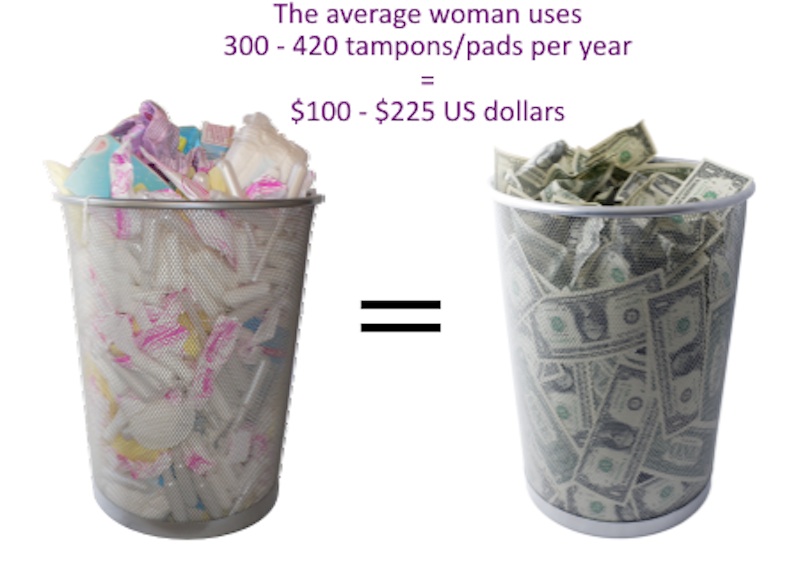
via DivaCup
At the end of May, Congresswoman Carolyn B. Maloney (D-NY) introduced a new version of proposed legislation that would require further research into the health effects of menstrual hygiene products. The bill, named The Robin Danielson Act of 2014, “would require the National Institutes of Health (NIH) to research whether menstrual hygiene products that contain dioxin, synthetic fibers, and other chemical additives like chlorine and fragrances, pose health risks,” according to a press release issued by Maloney’s campaign. The Robin Danielson Act would also demand that the FDA publicly disclose the list of contaminants in menstrual hygiene products. This latter portion of the legislation is really important because many of these companies that sell menstruation products keep the public unaware of the chemicals used in the bleaching and fragrances of pads and tampons. Alexandra Scranton, Director of Science and Research for Women’s Voices for the Earth and author of the report Chem Fatale, explained the importance of knowing what elements are used in menstruation products. Scranton insists, “A number of different chemicals of concern may be found in feminine care products, but there simply has not been sufficient research to determine the effects of these chemicals on one of the most sensitive and absorptive areas of a woman’s body.” Given that little research has been done on these potential toxins, we have no way of knowing if there is any connection between menstruation products and cervical cancer, or any vaginal/uterine health issues. That type of scientific ignorance is medically and socially irresponsible towards people who have periods and rely on hygiene products like pads, tampons, cups, liners, and sponges.
For people to make informed choices about their health and hygiene, there must be more information about menstruation products. People who have periods have already been down this road of insubstantial research and unsafe marketing. In 1979, Proctor and Gamble released Rely, marketed as a super absorbent tampon made with compressed beads of polyester and carboxymethyl cellulose that could absorb up to 20 times its weight in fluid. Rely entered the menstrual hygiene product scene although there were no federal guidelines as to what materials were safe to insert into a vagina. Because Rely could hold so much moisture — more moisture than what is generally present in a vagina — if the product remained inside the body for long enough, it would dry the vaginal walls and lacerate the user’s vagina as it was removed. Furthermore, when researchers finally looked into Rely, the product was found to filter the bacteria that causes toxic shock syndrome and many people were ill or died because capitalistic ventures took precedence over people’s vaginal health.
I like my menstruation products. But, do you know what I like even better? I like the idea that what I put inside, outside, or anywhere near my vagina is safe enough to be in the immediate vicinity of my uterus. The blatant disregard that the government and consequently scientific research has demonstrated towards people who menstruate is but an extension of our society’s institutionalized misogyny. For example, a few groups have been doing studies on how Viagra affects people with penises, even though the pill was approved by the FDA in 1998, but Congresswoman Maloney is proposing her legislation for the government to step up its menstrual hygiene product regulations for the sixth time. Since 1999, the United States government has rejected attempts to make better provisions for menstrual hygiene management. The government and sanitary products companies’ attitudes suggest that when the health of people who have periods is at stake, their wellbeing is less than a major priority. We should not have to beg the government to make the necessary provisions to keep our bodies safe. People who menstruate cannot afford unsafe standards or provisions for hygiene products.

